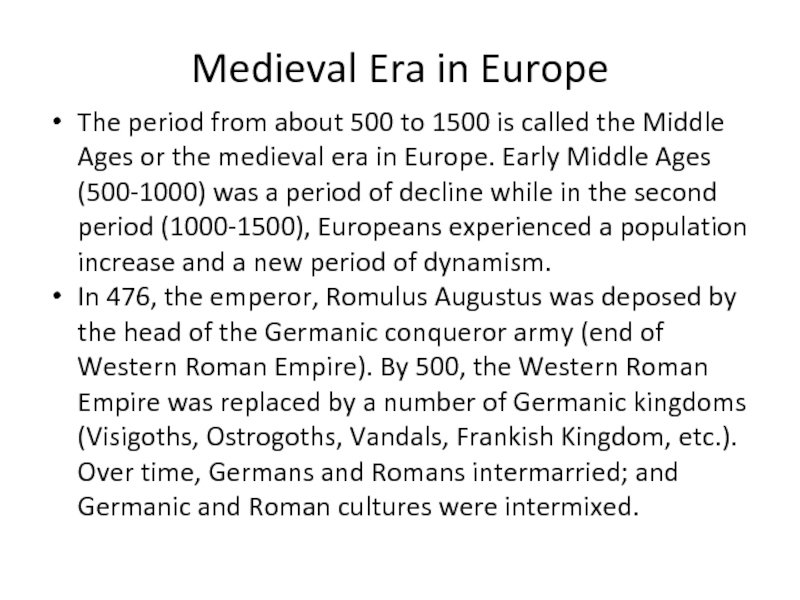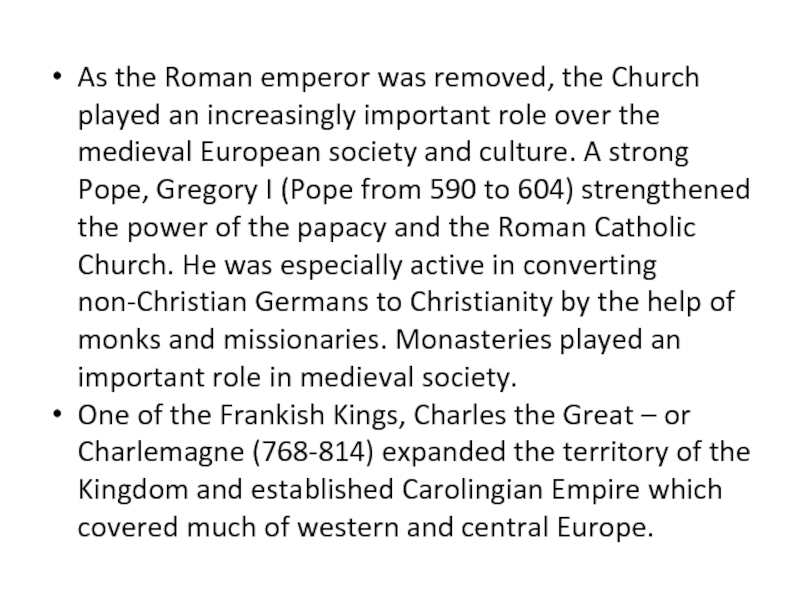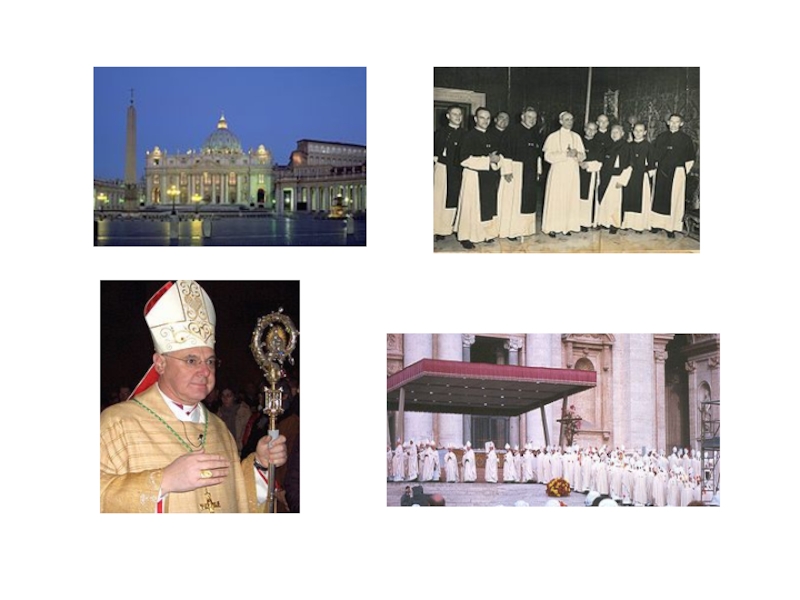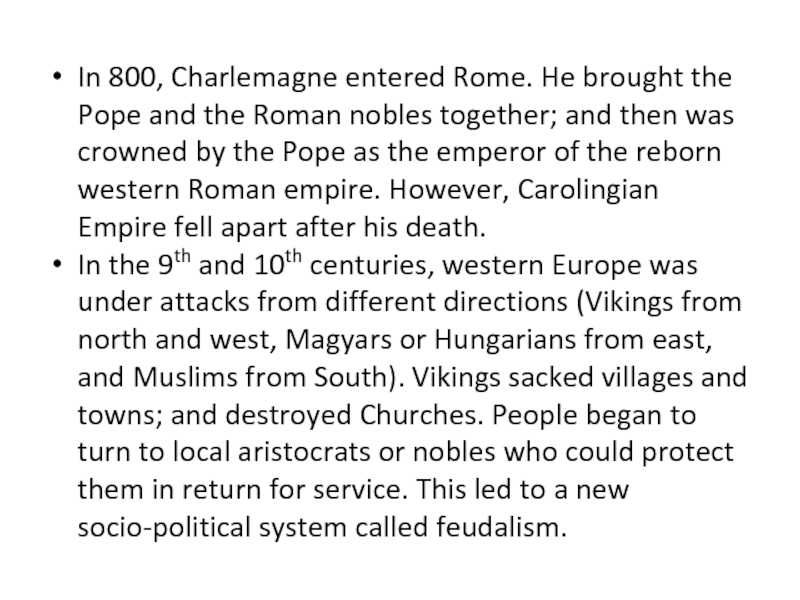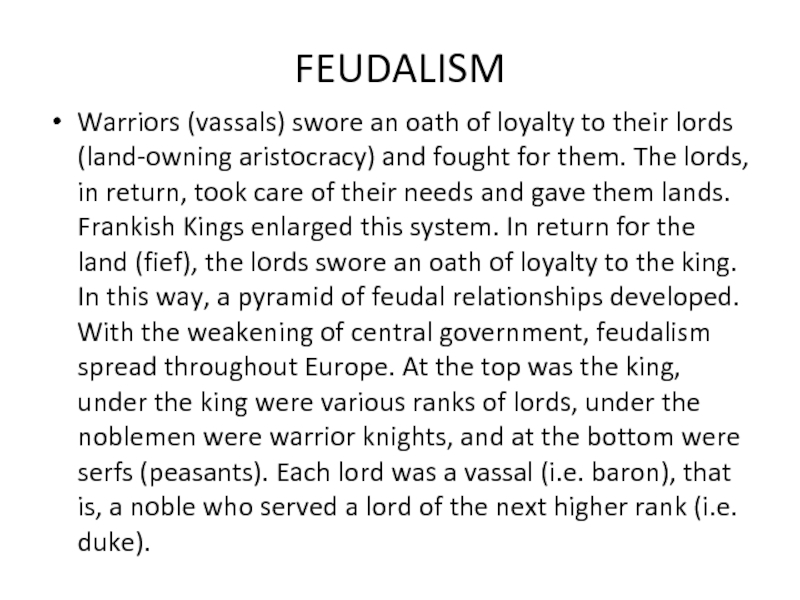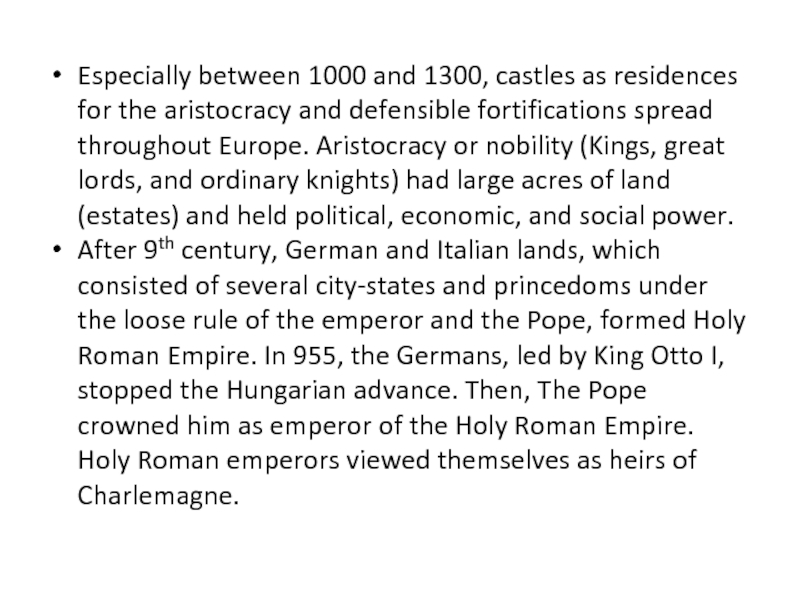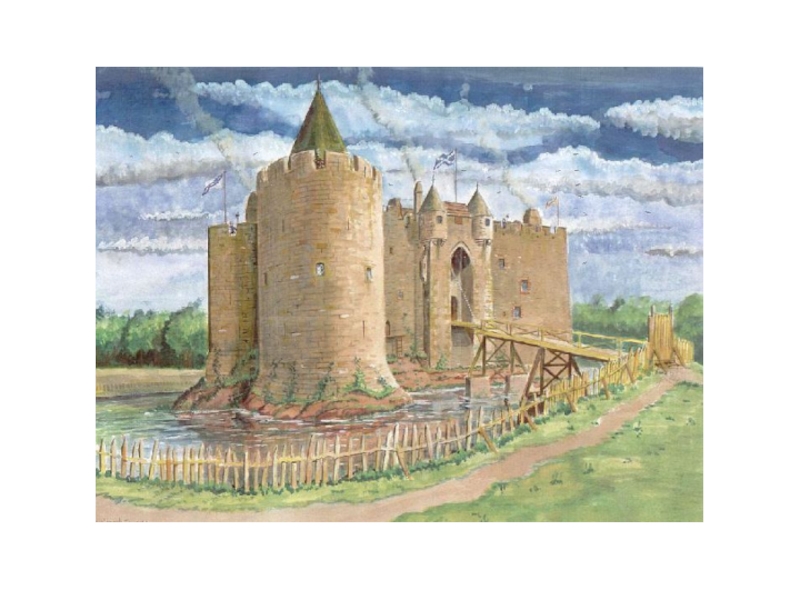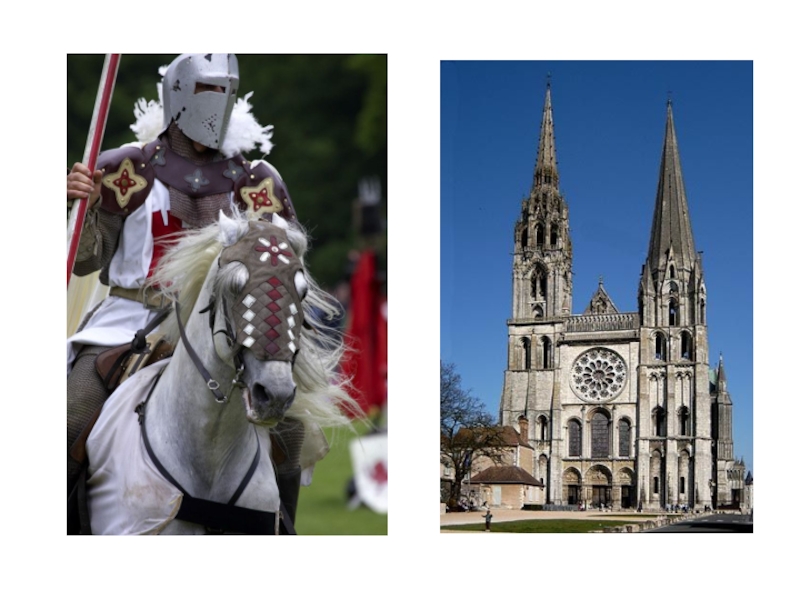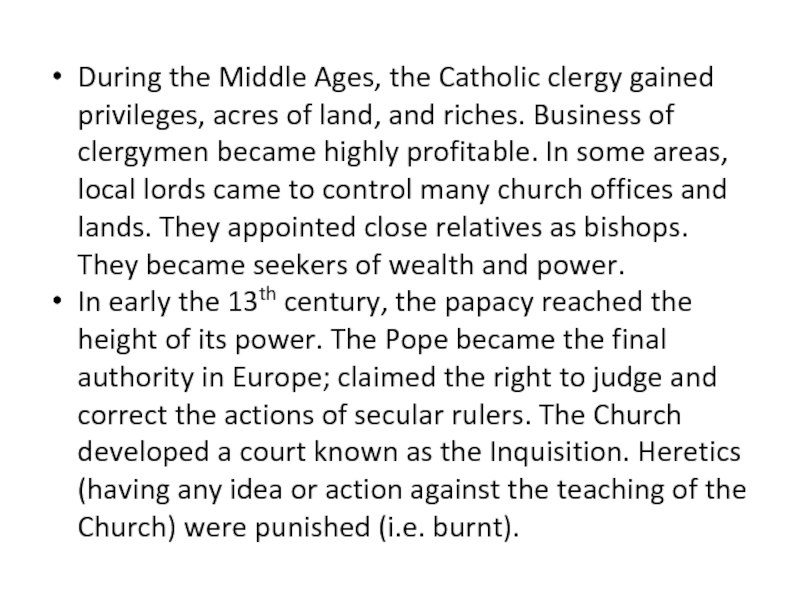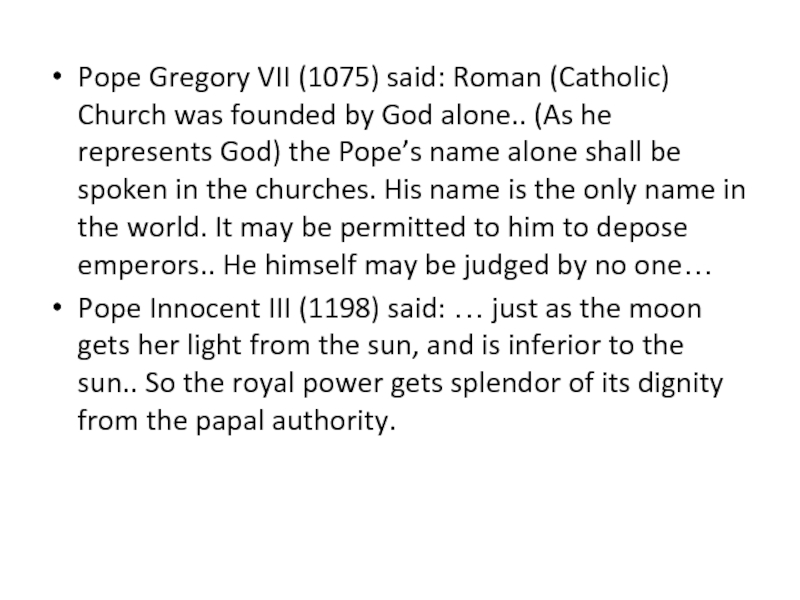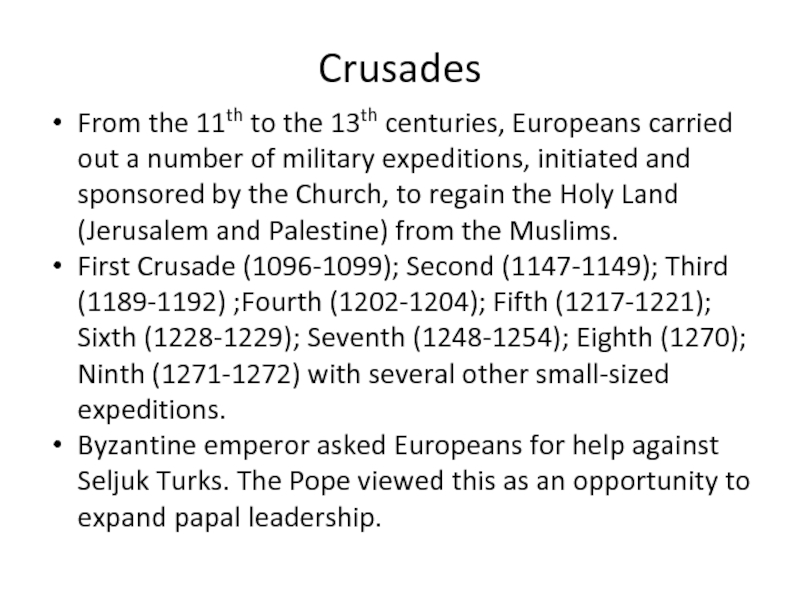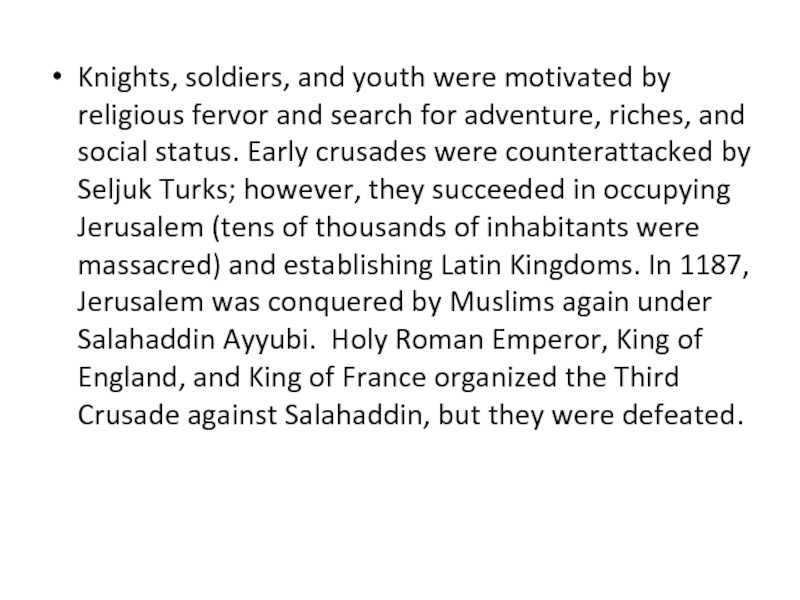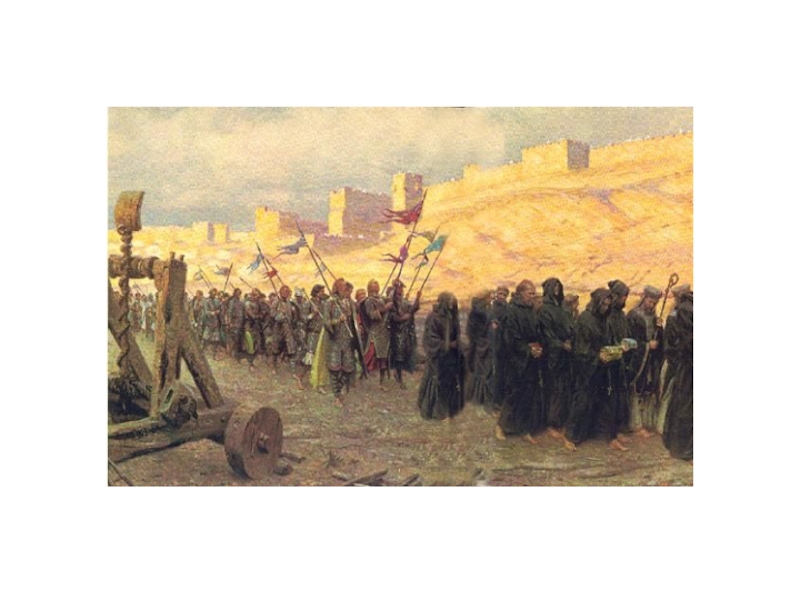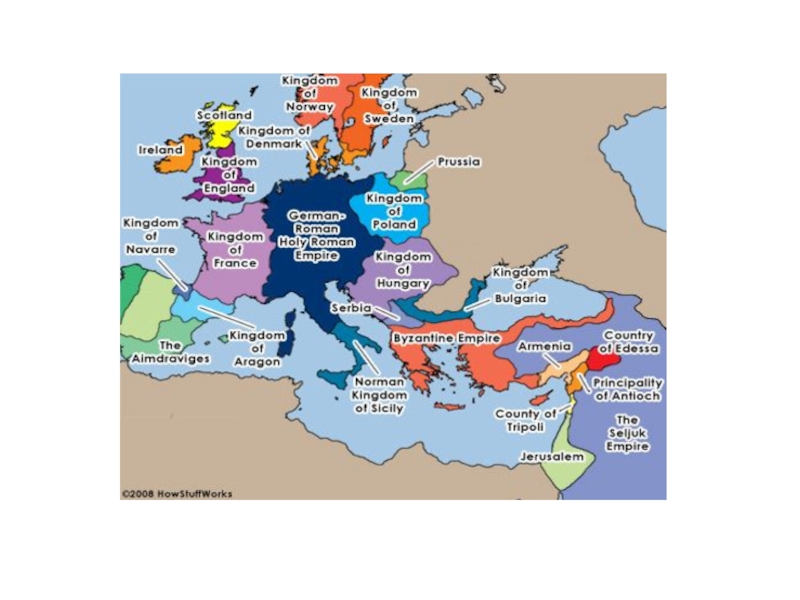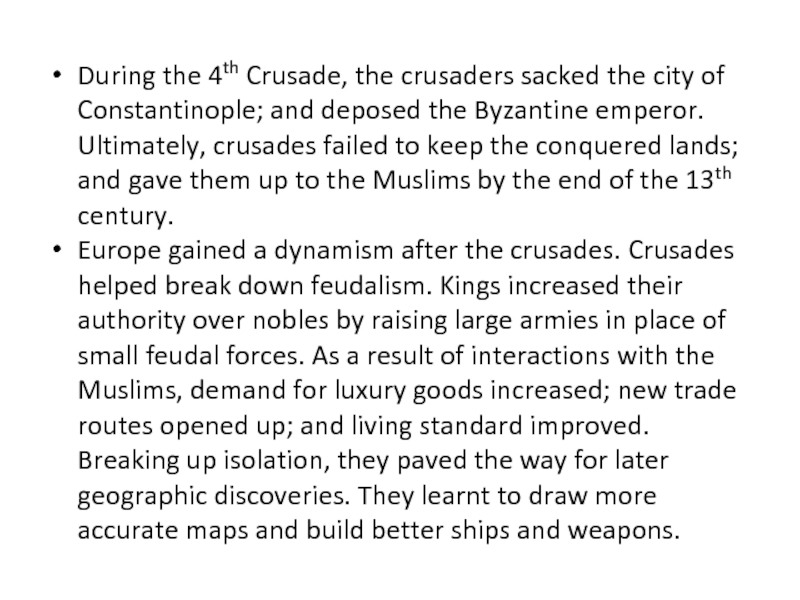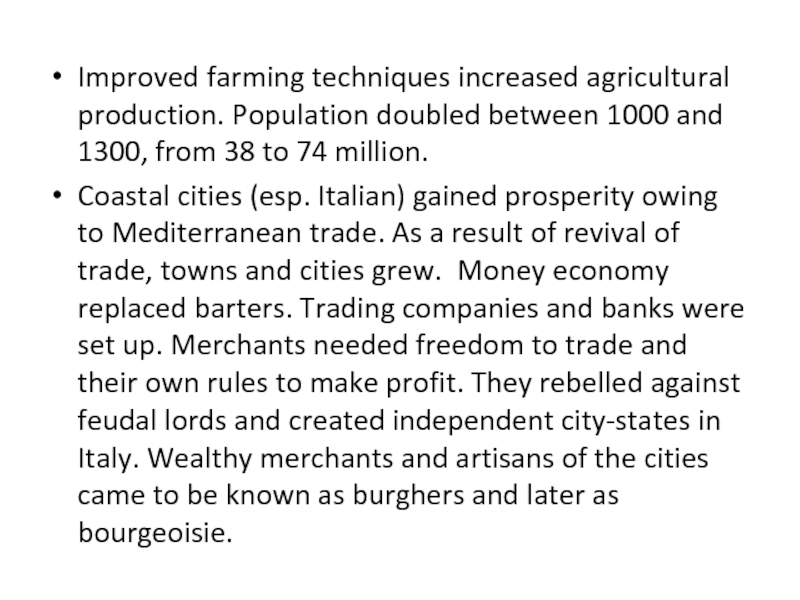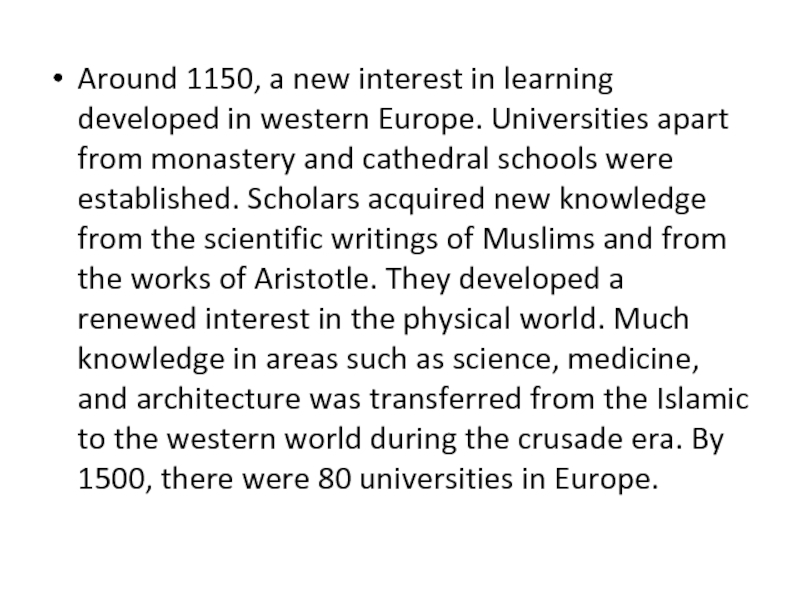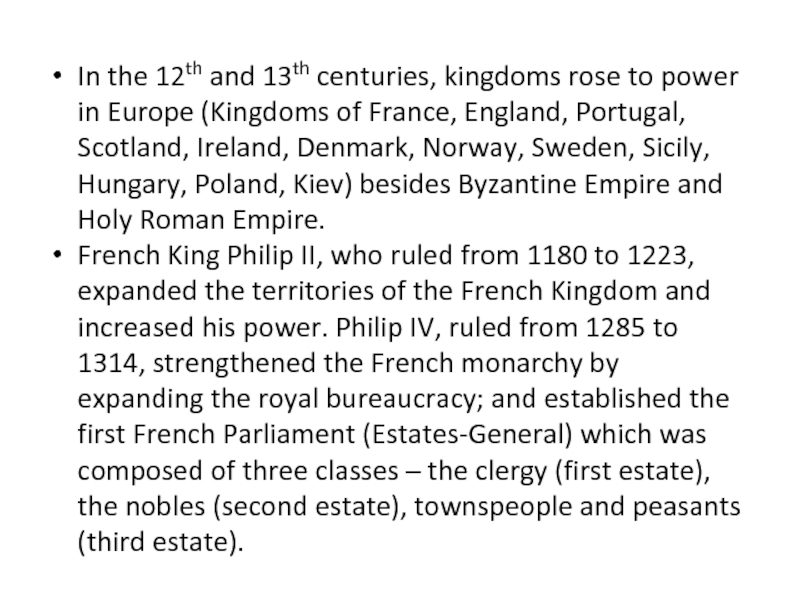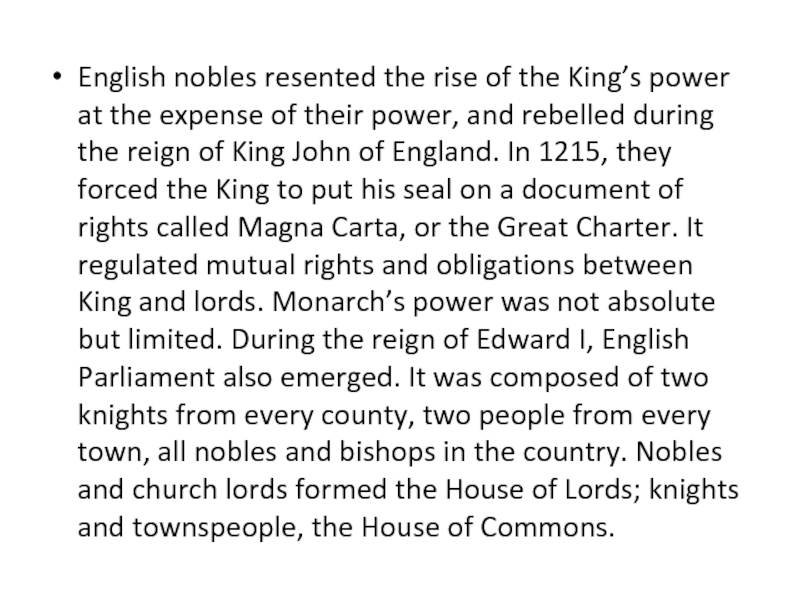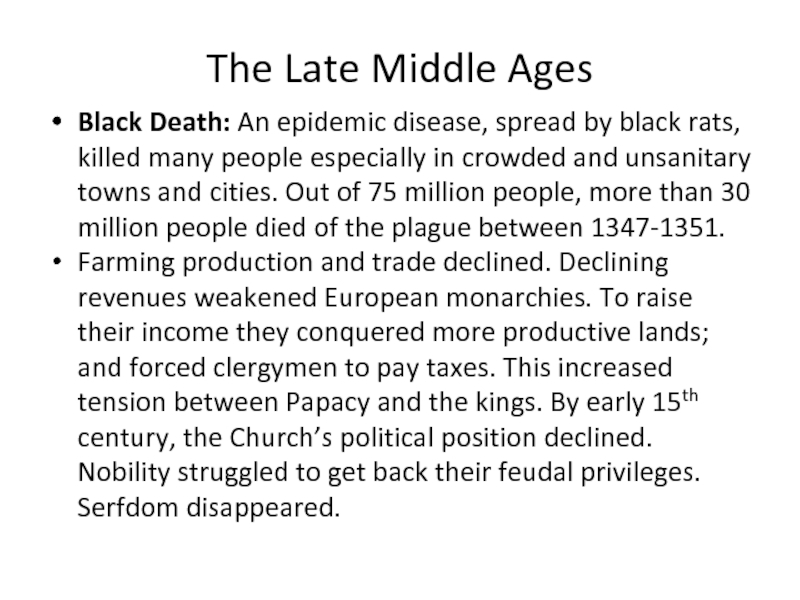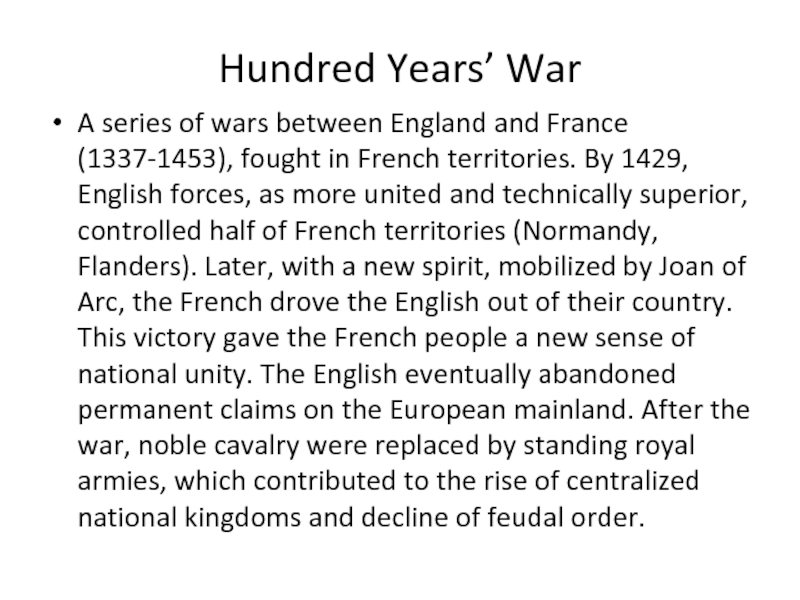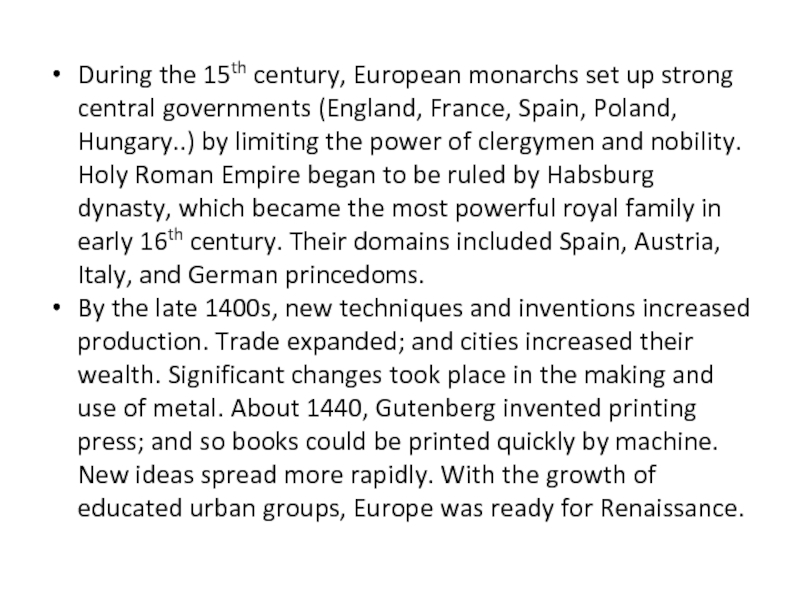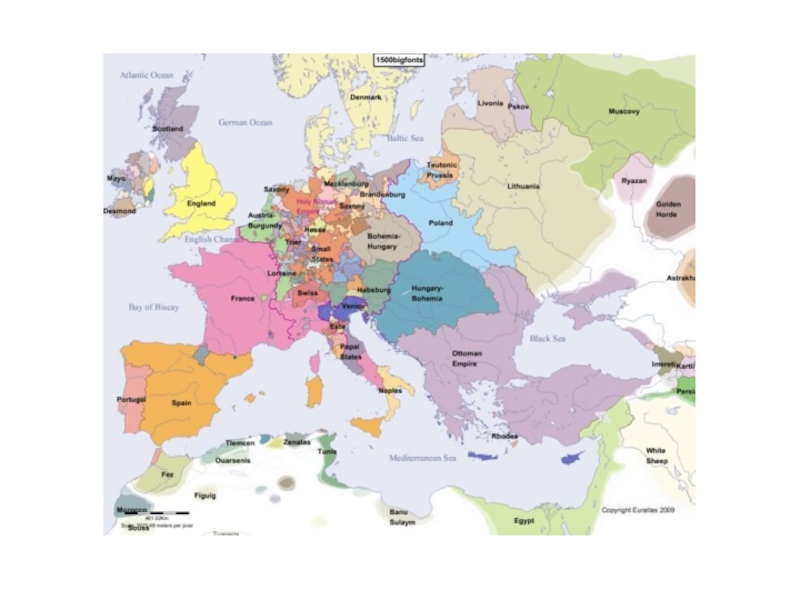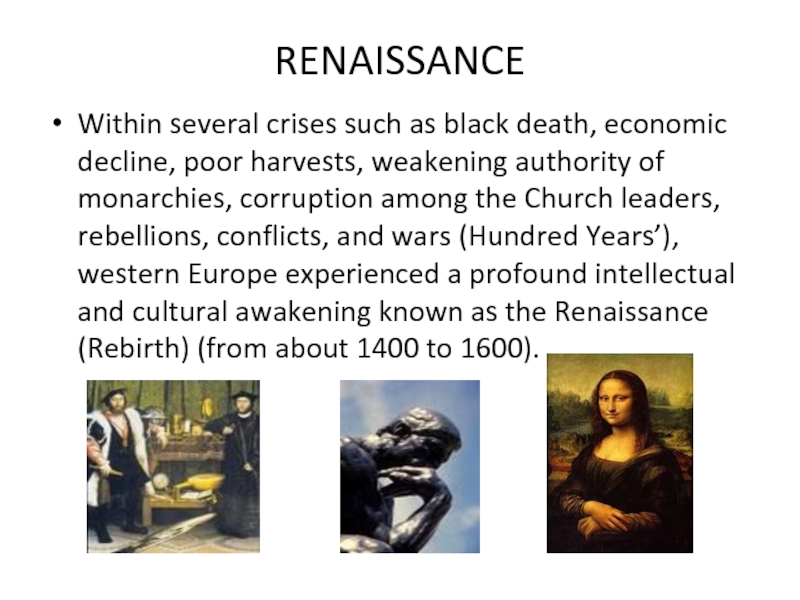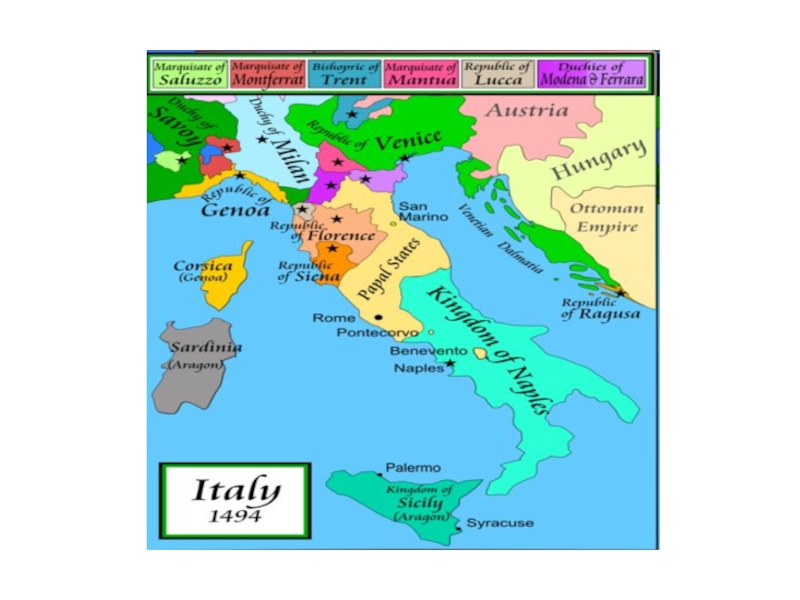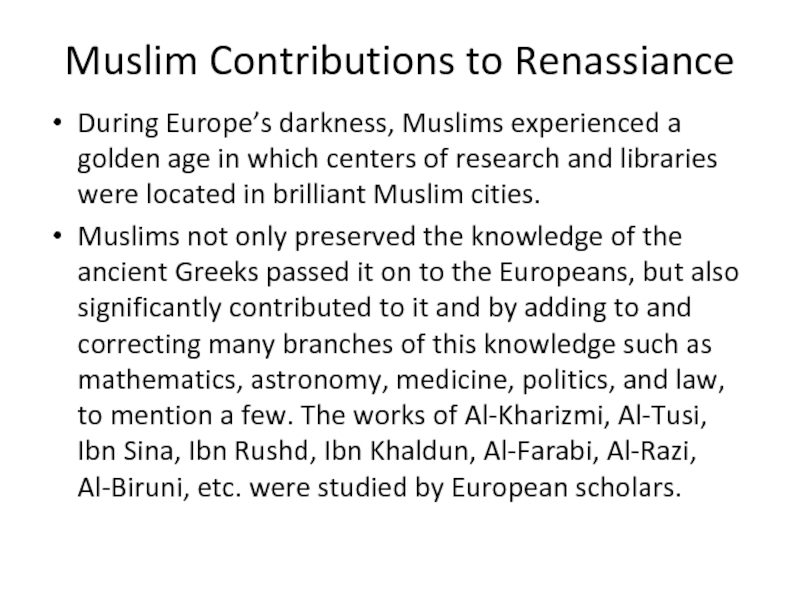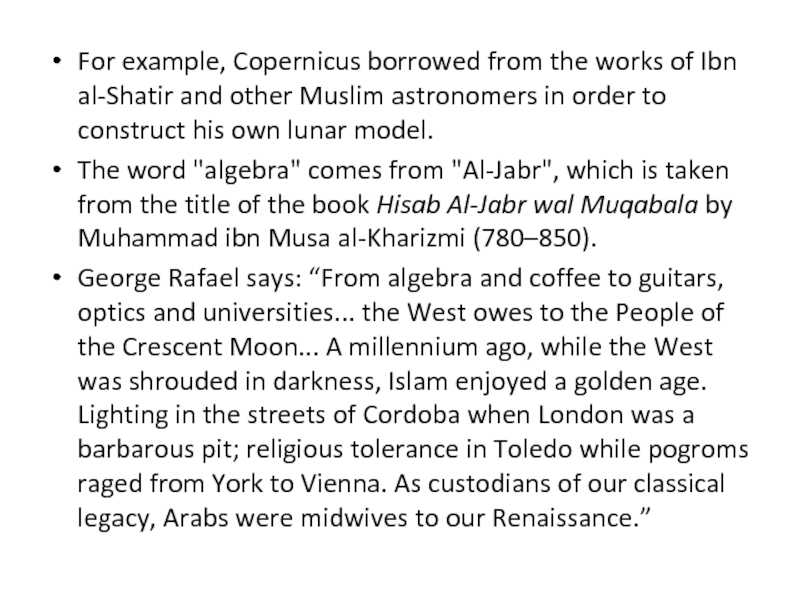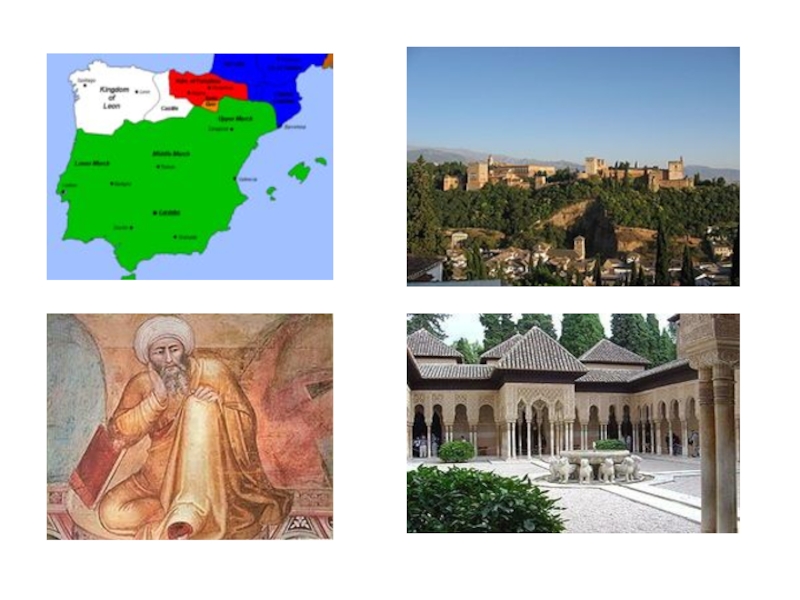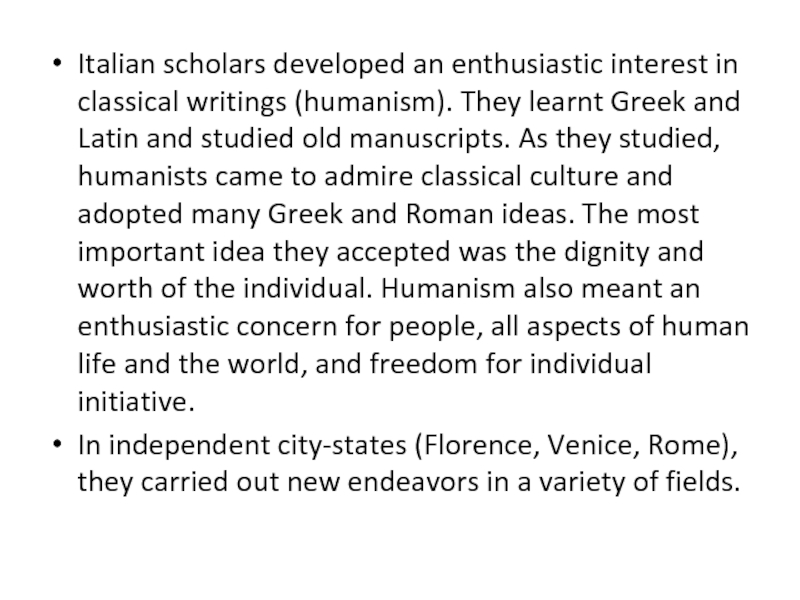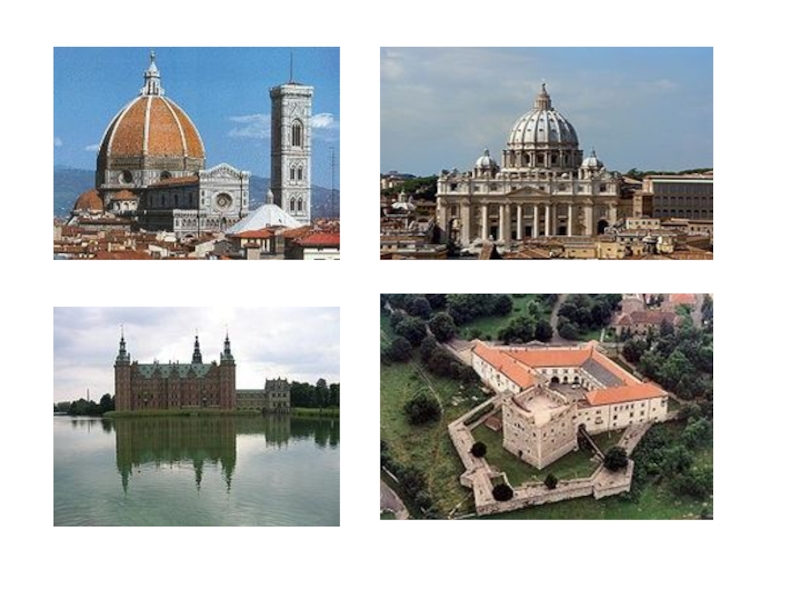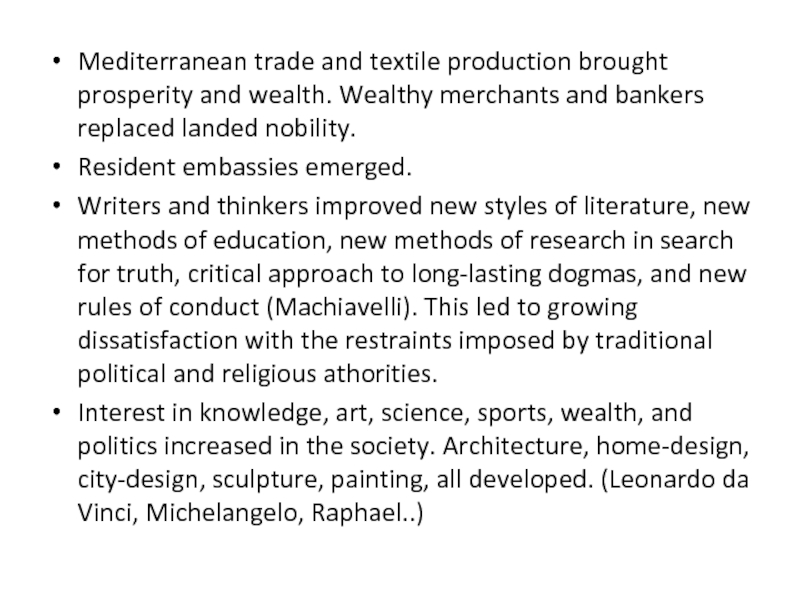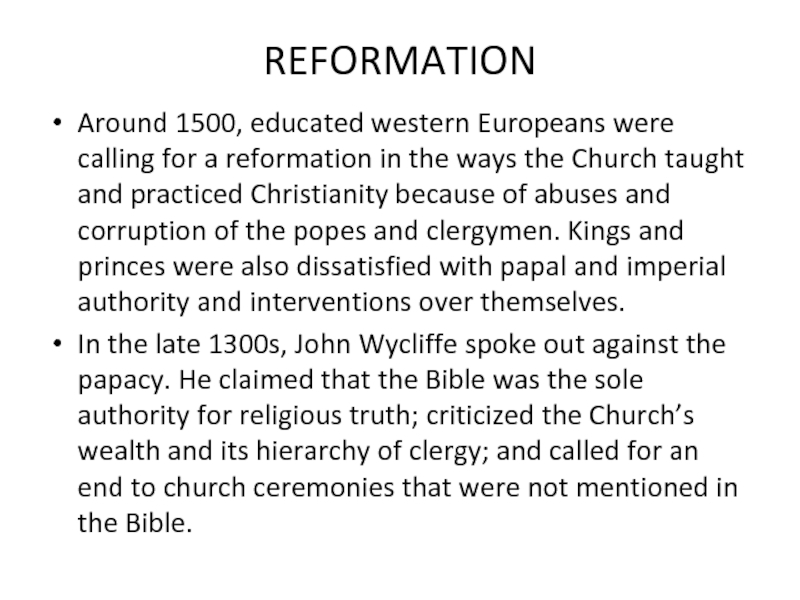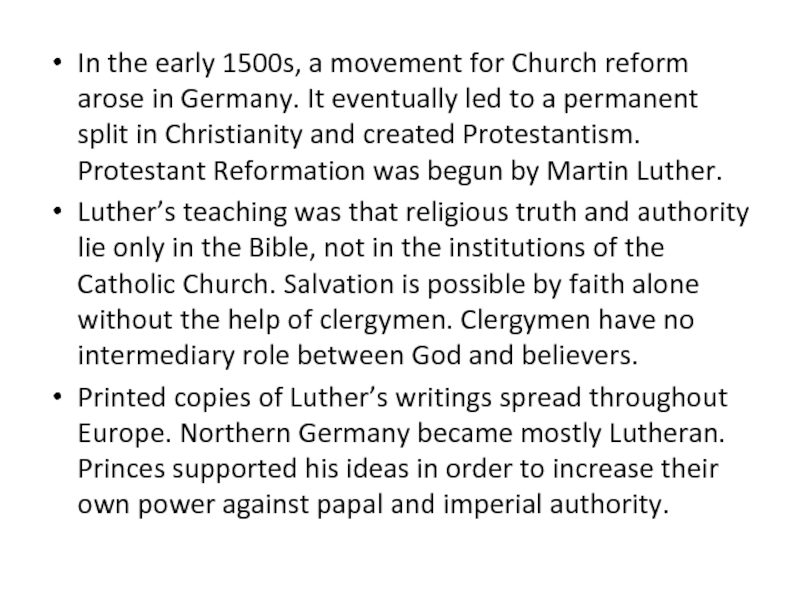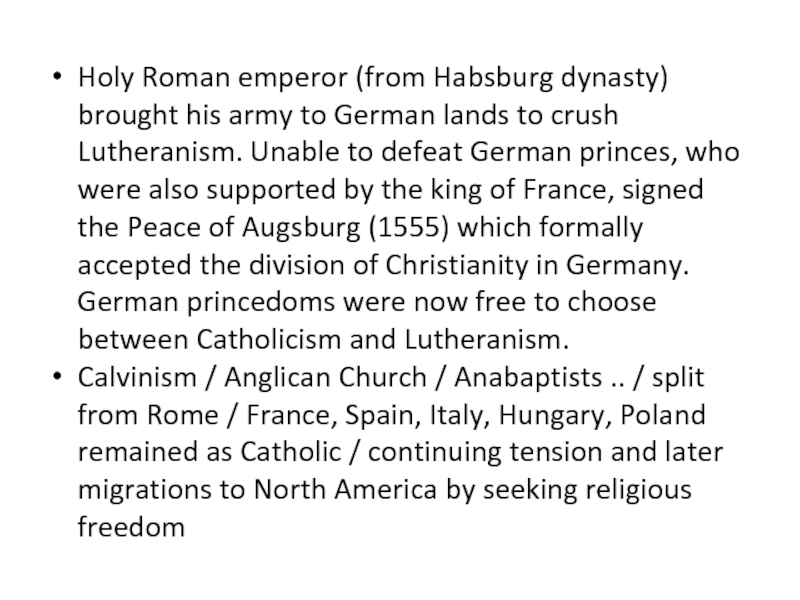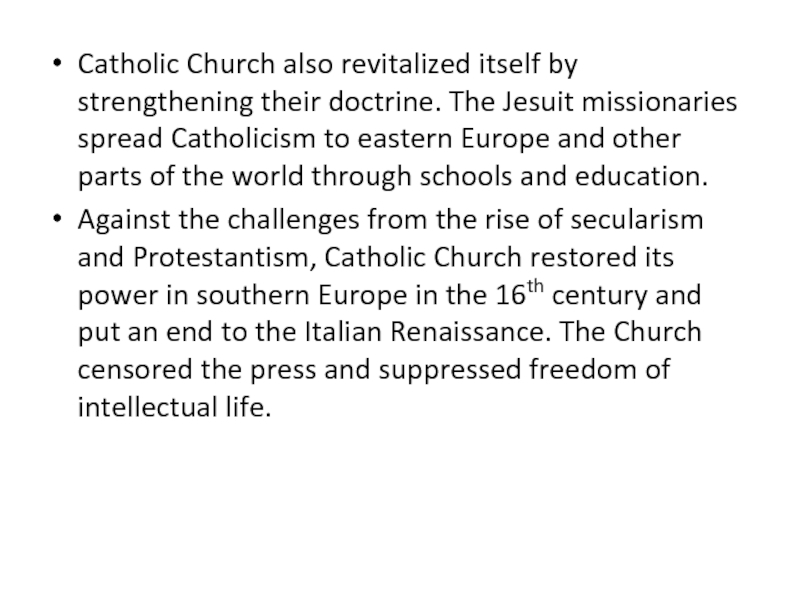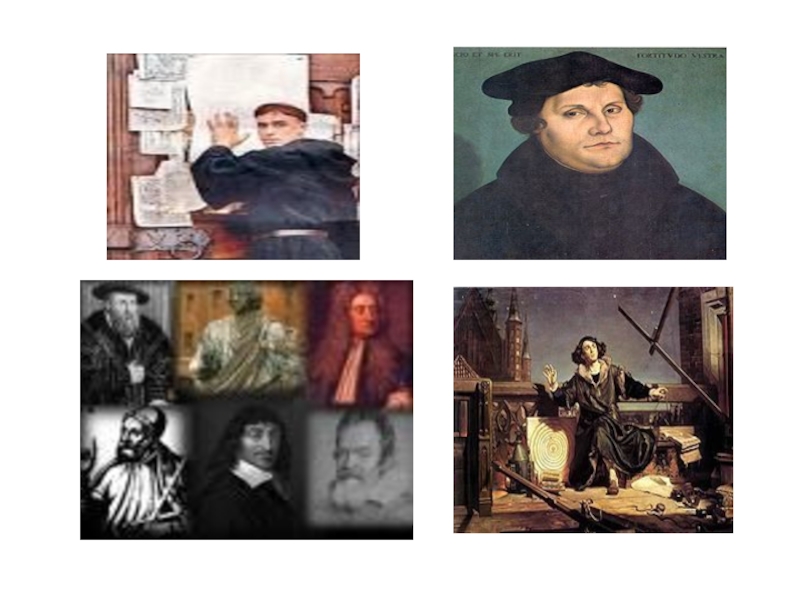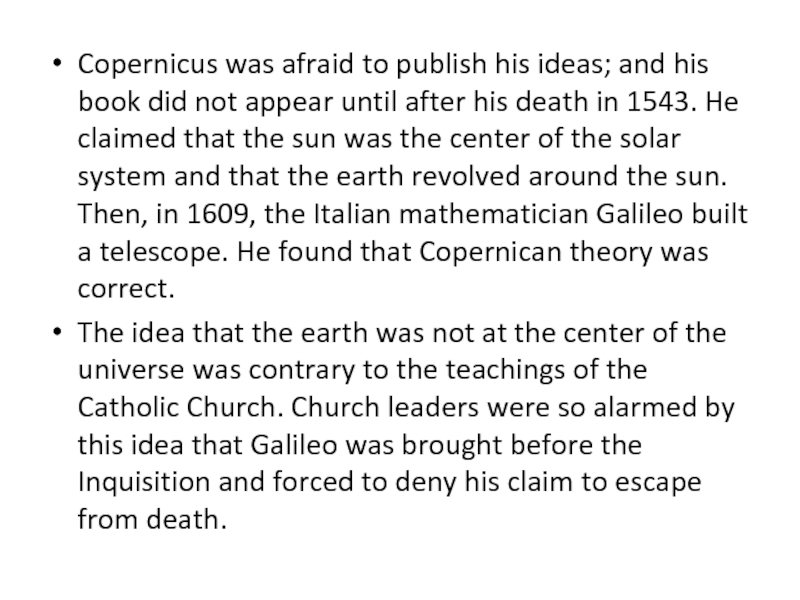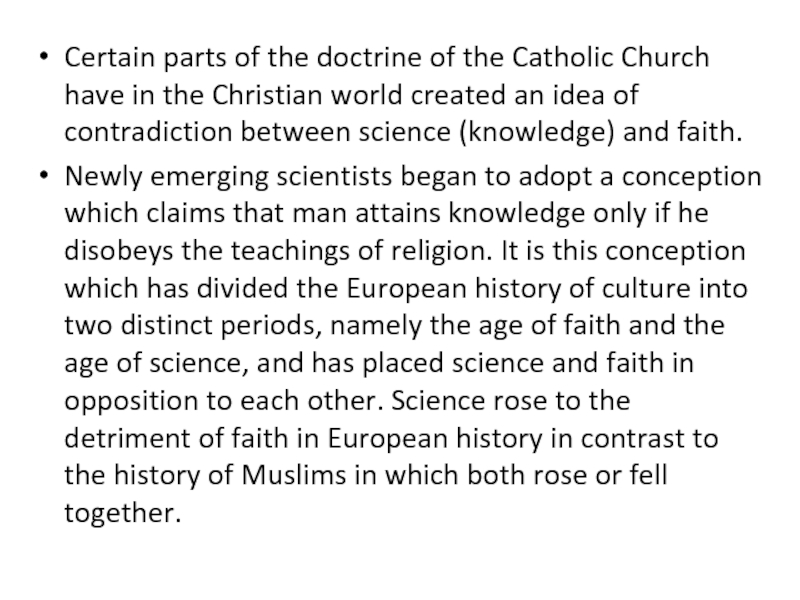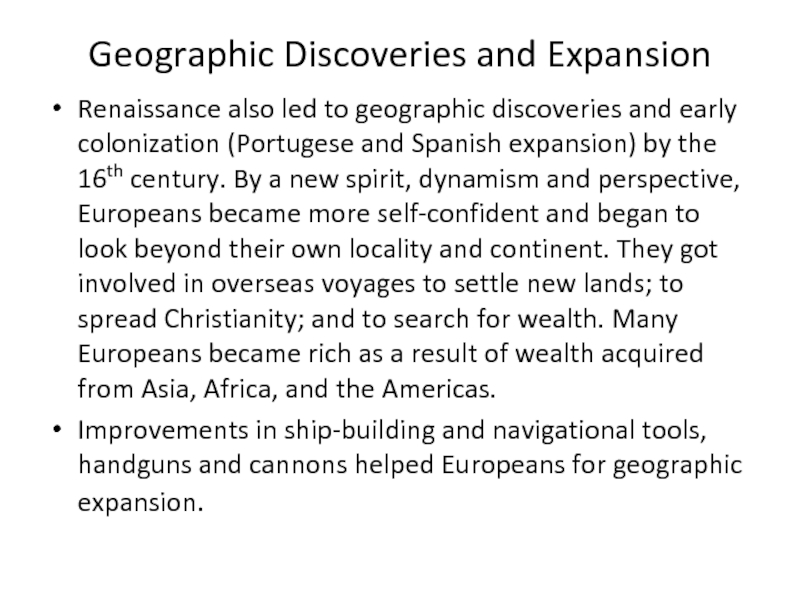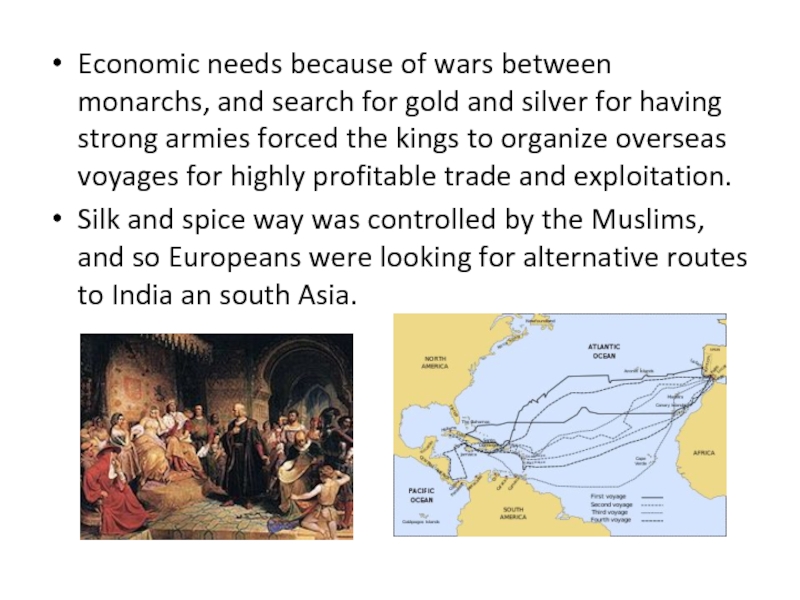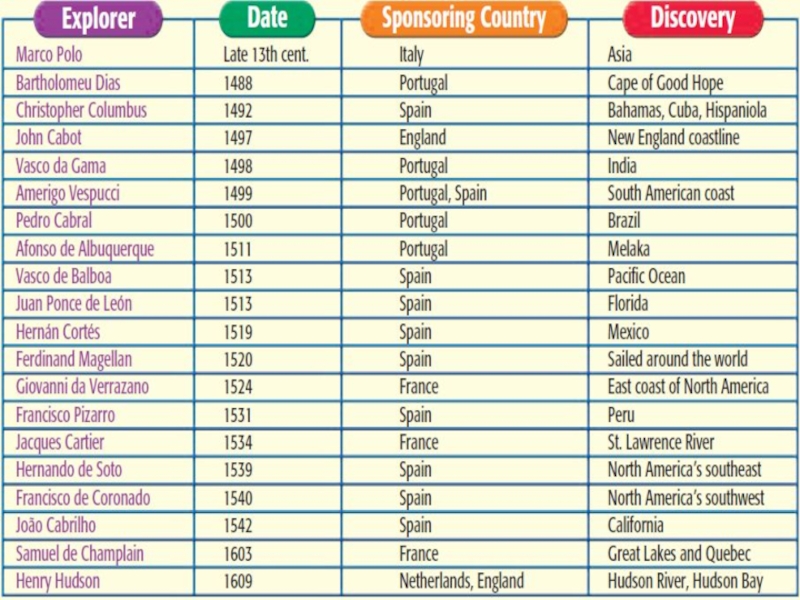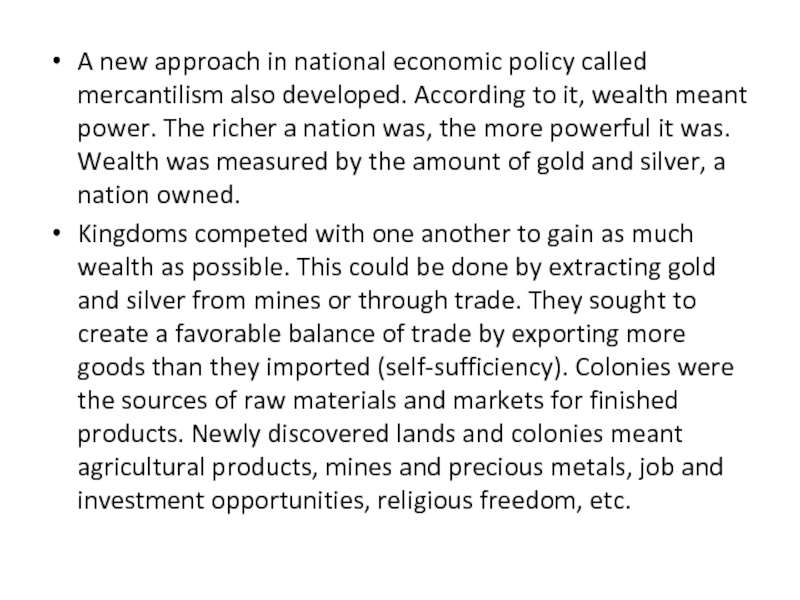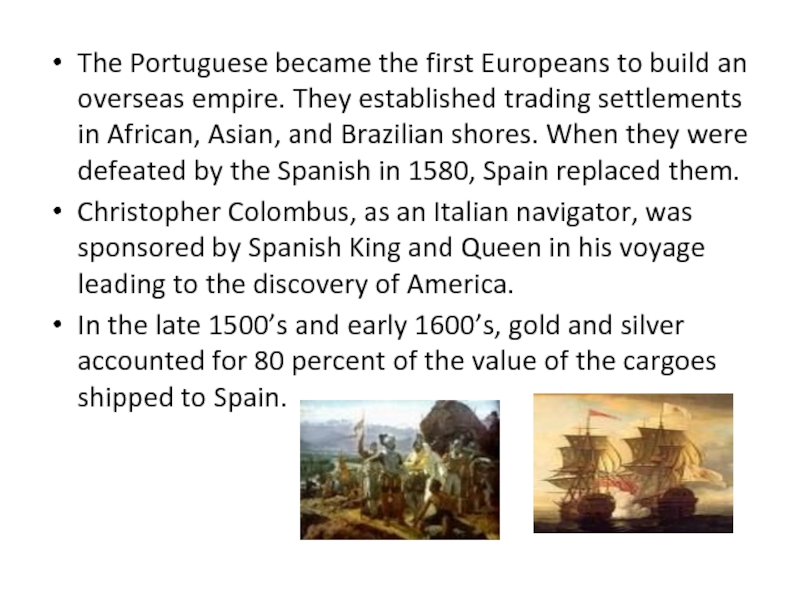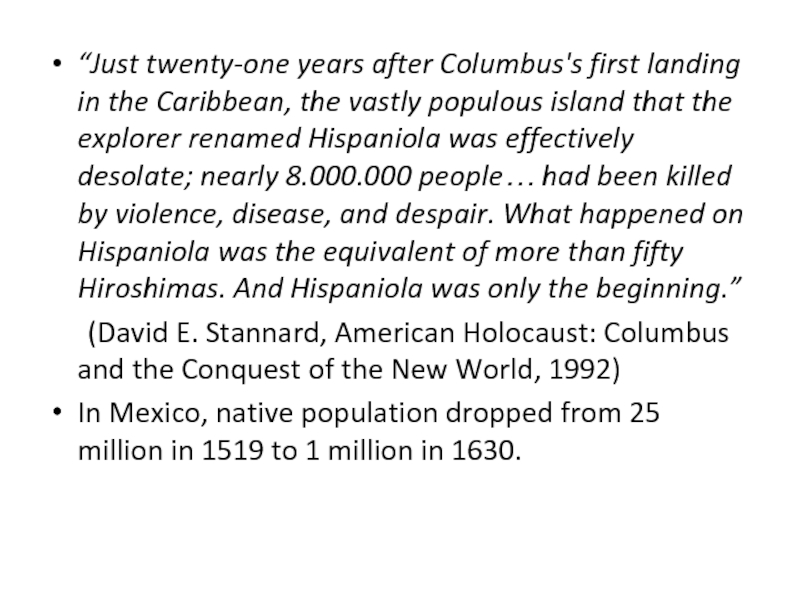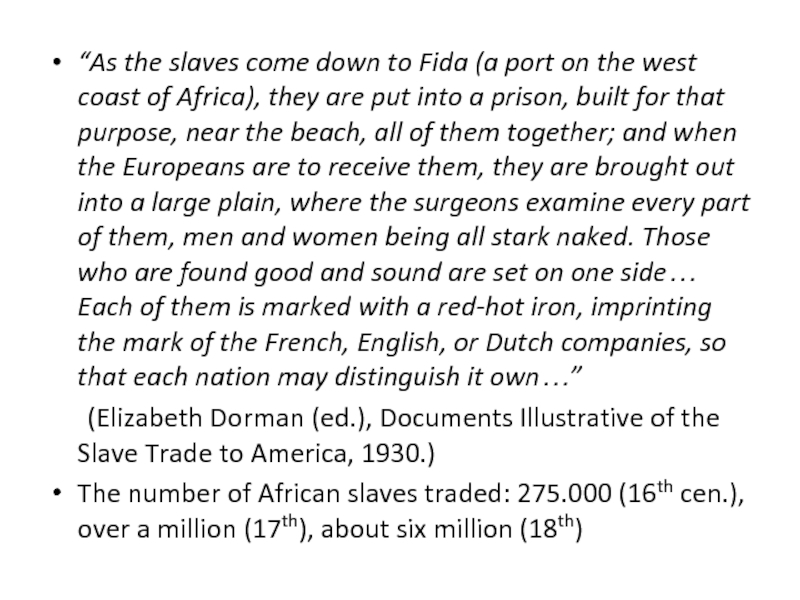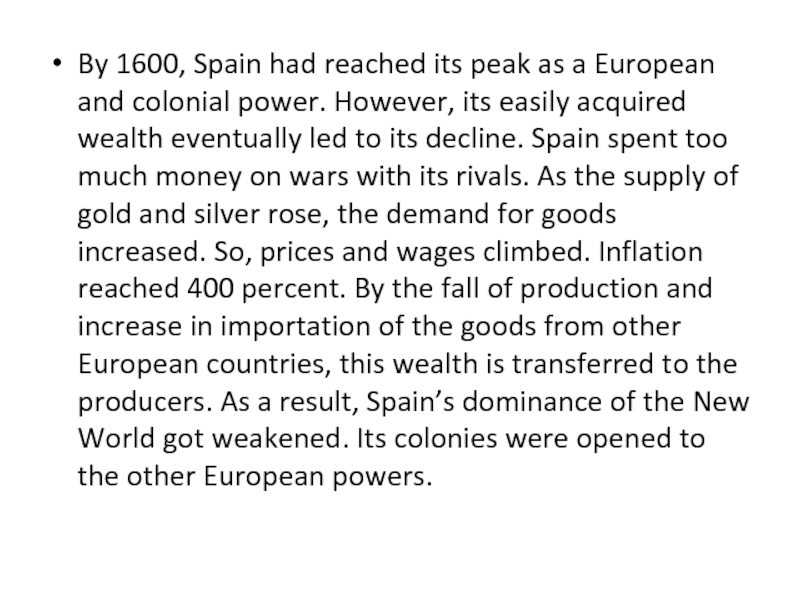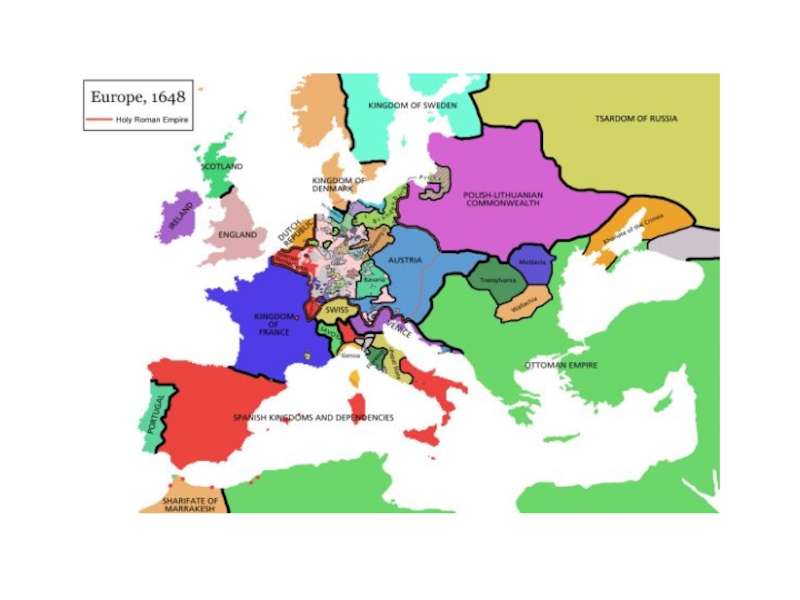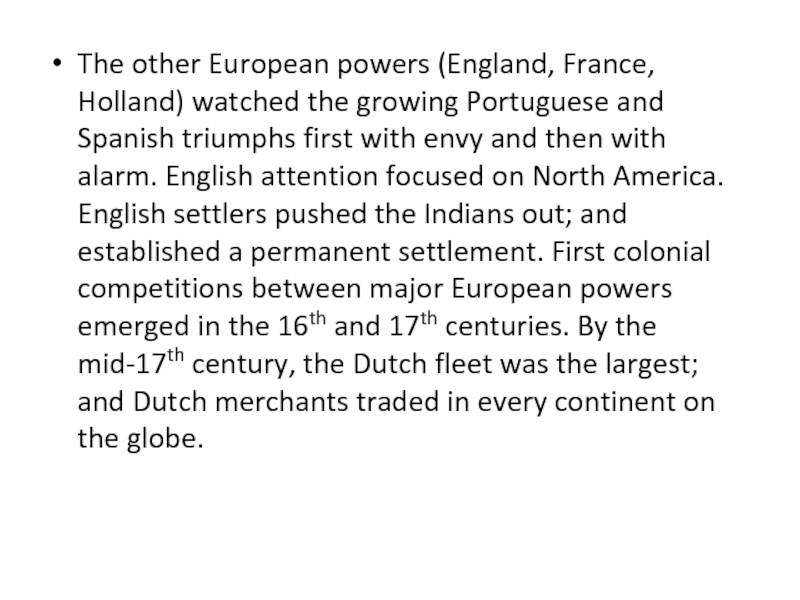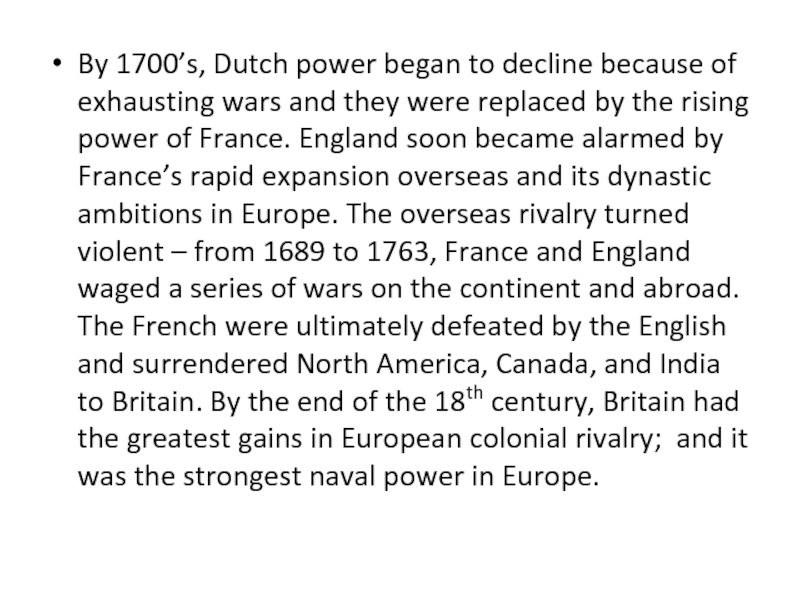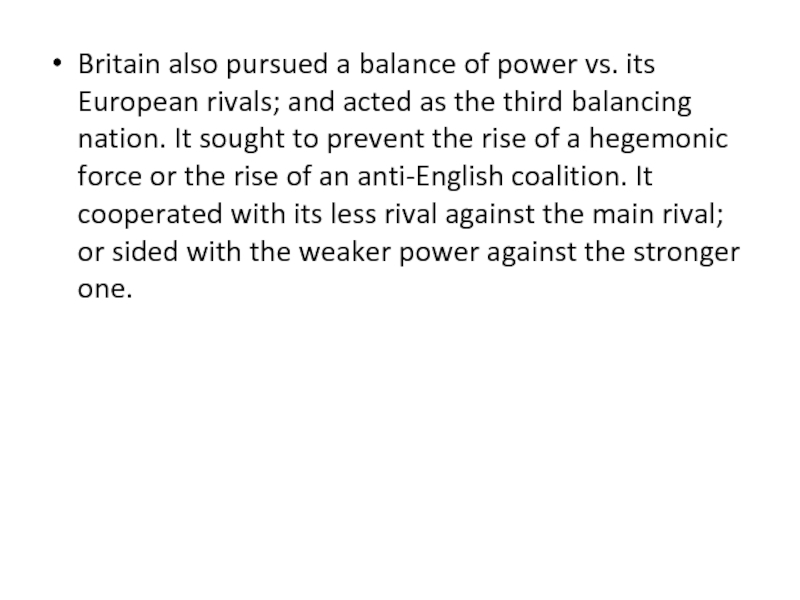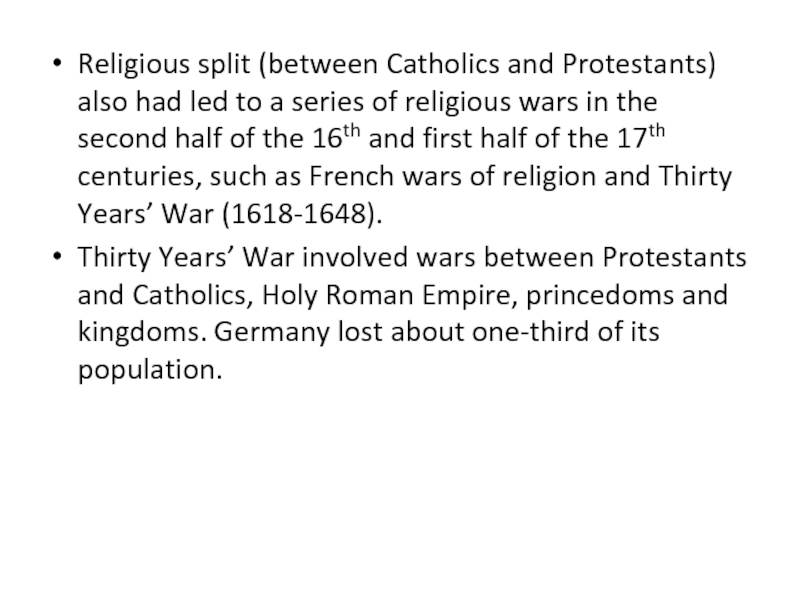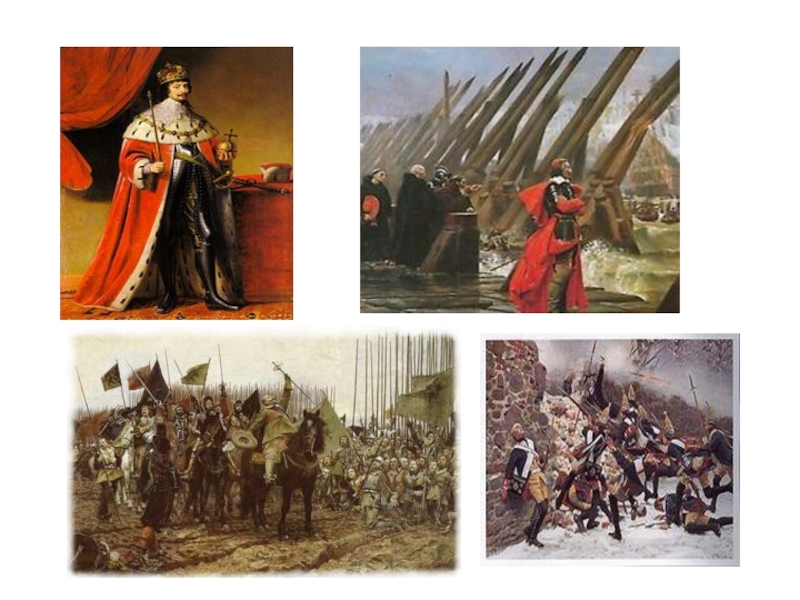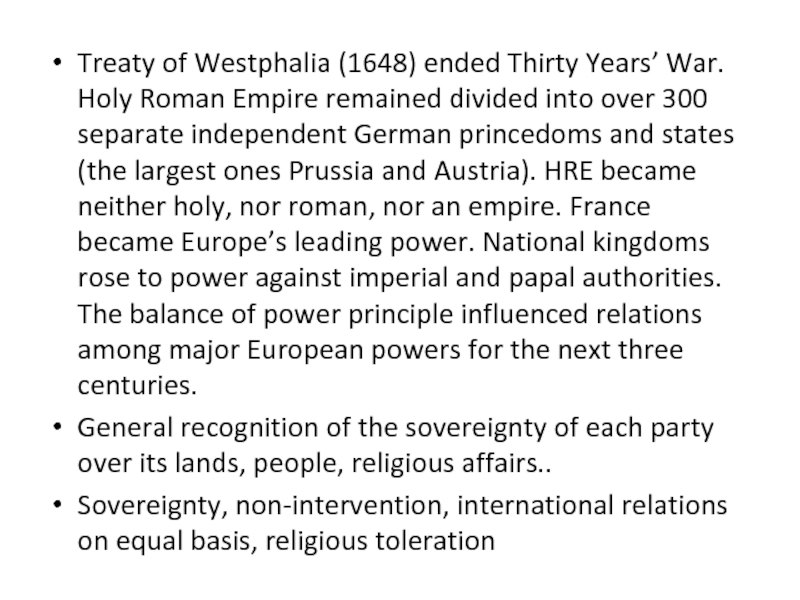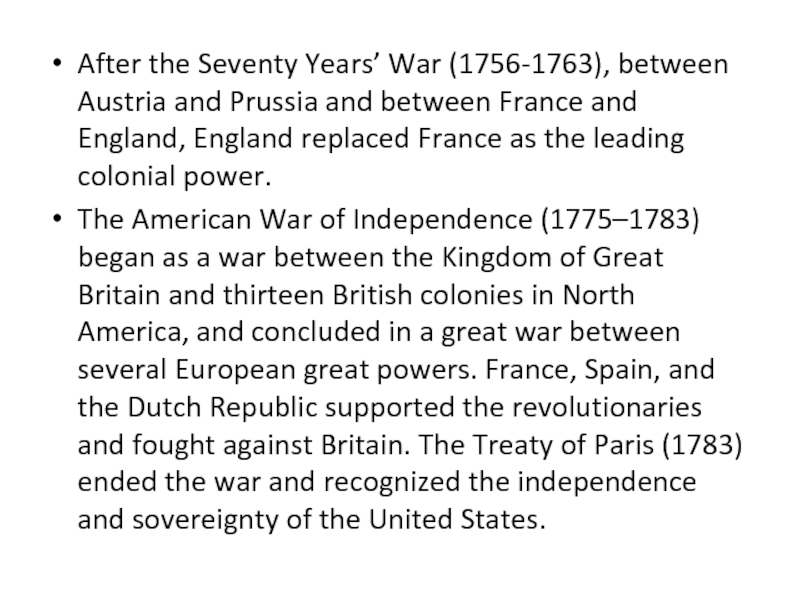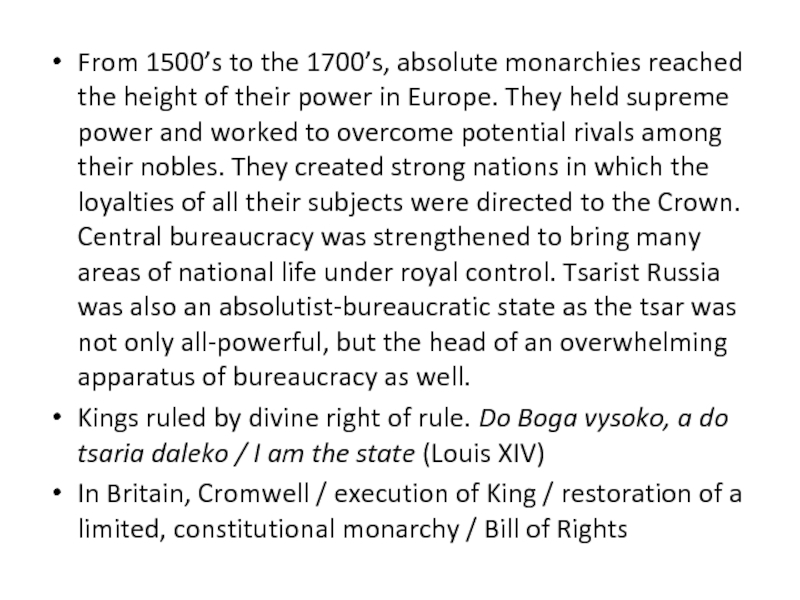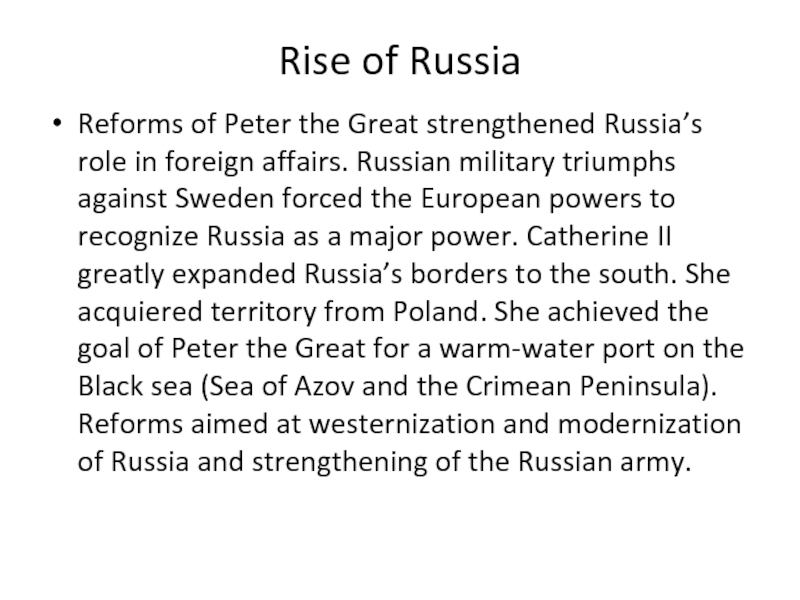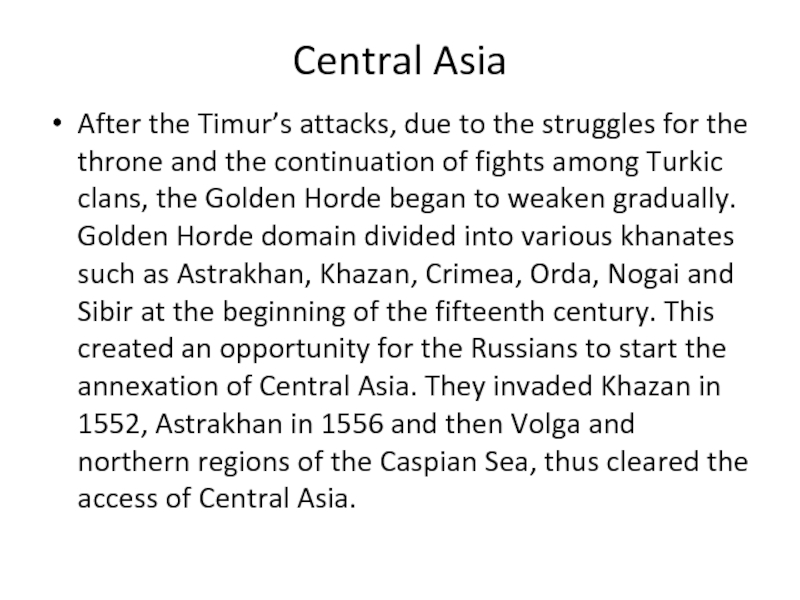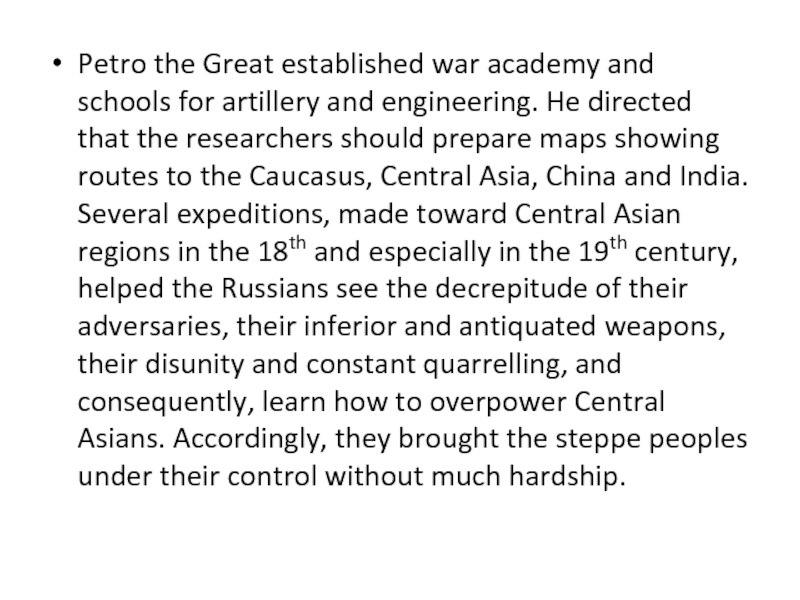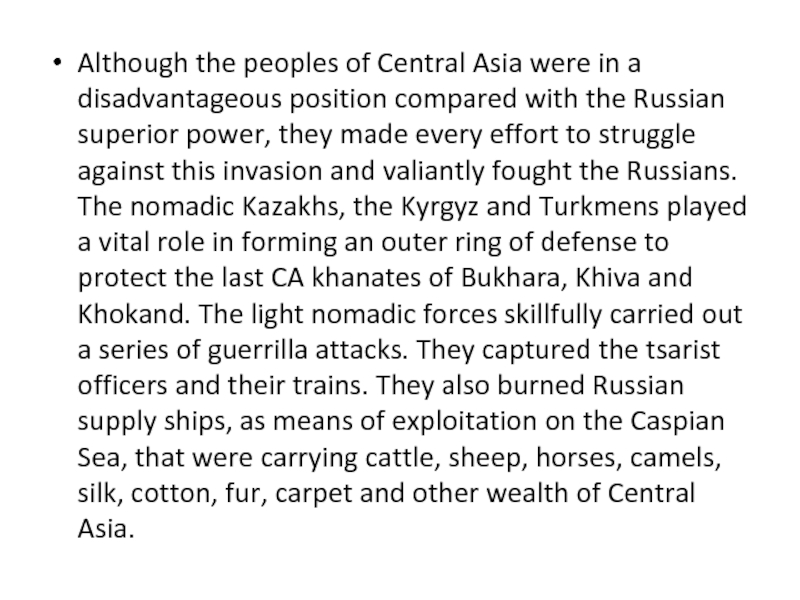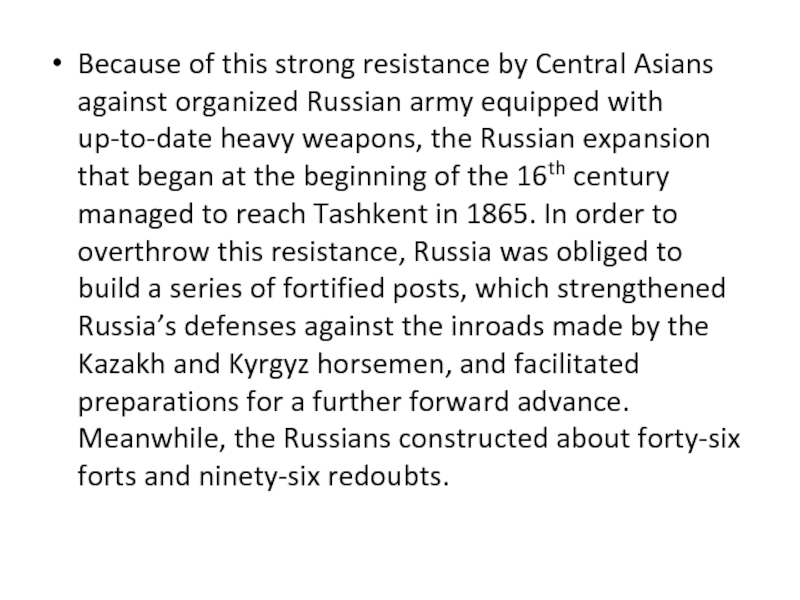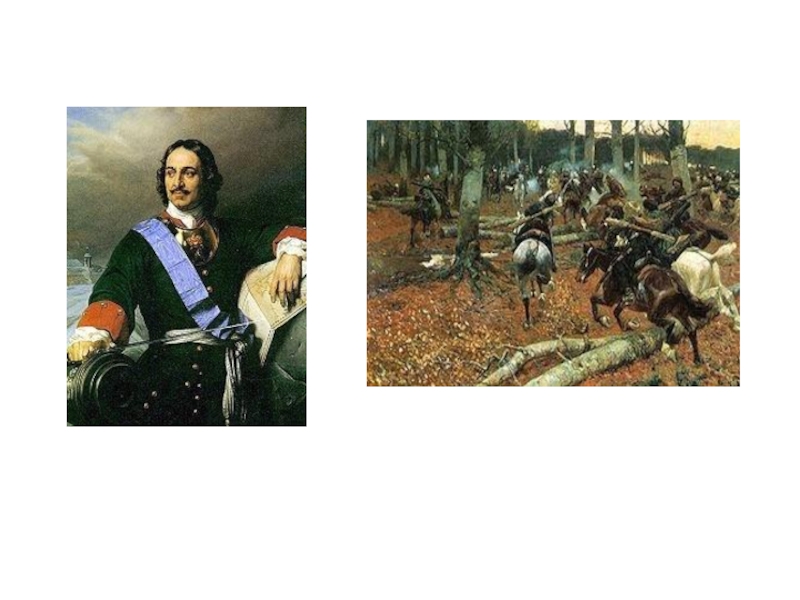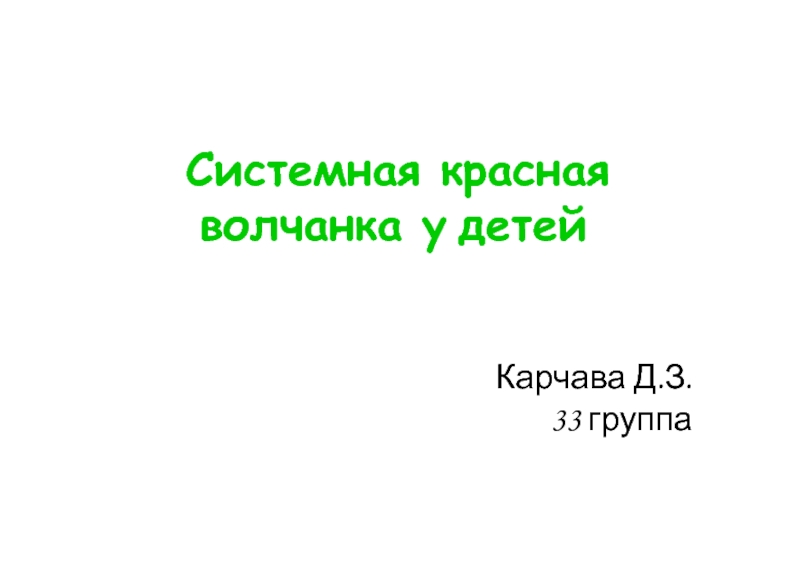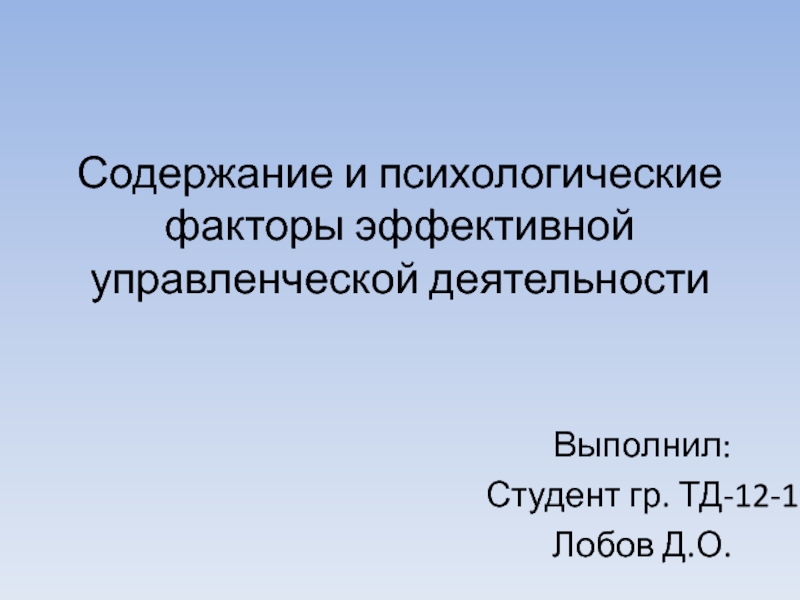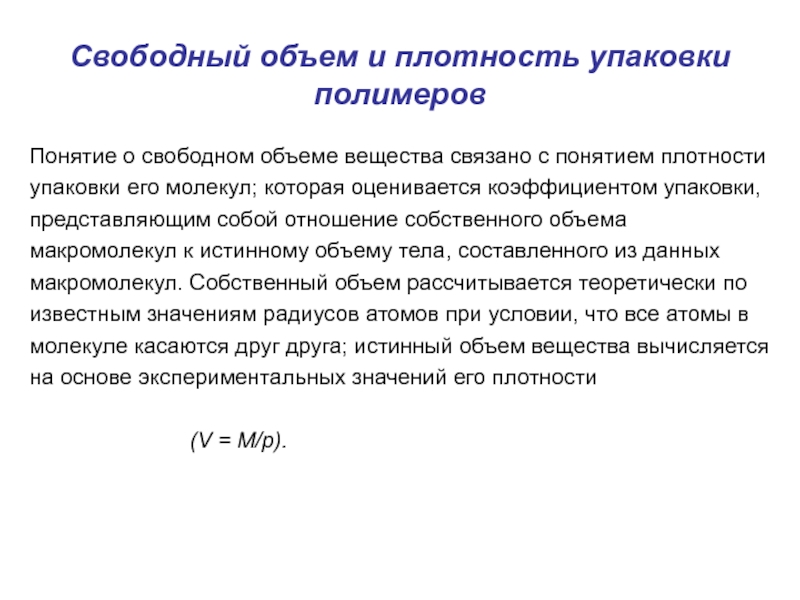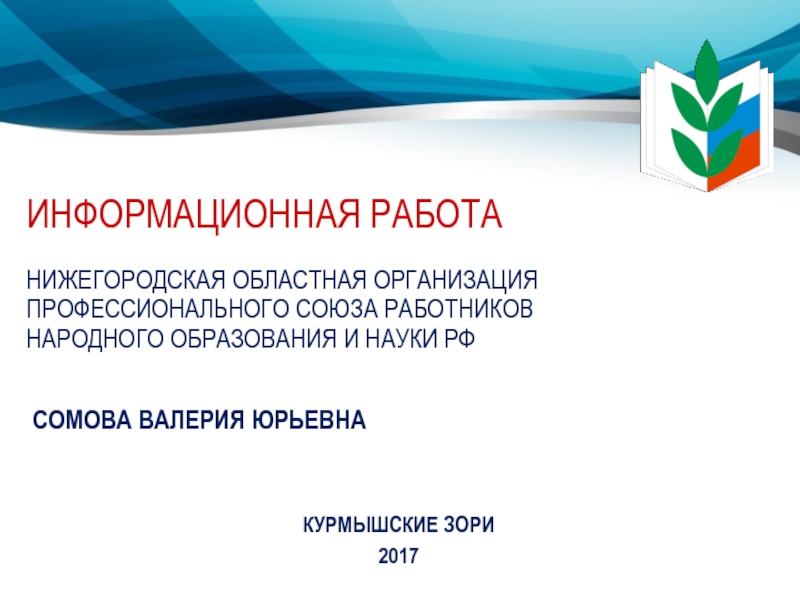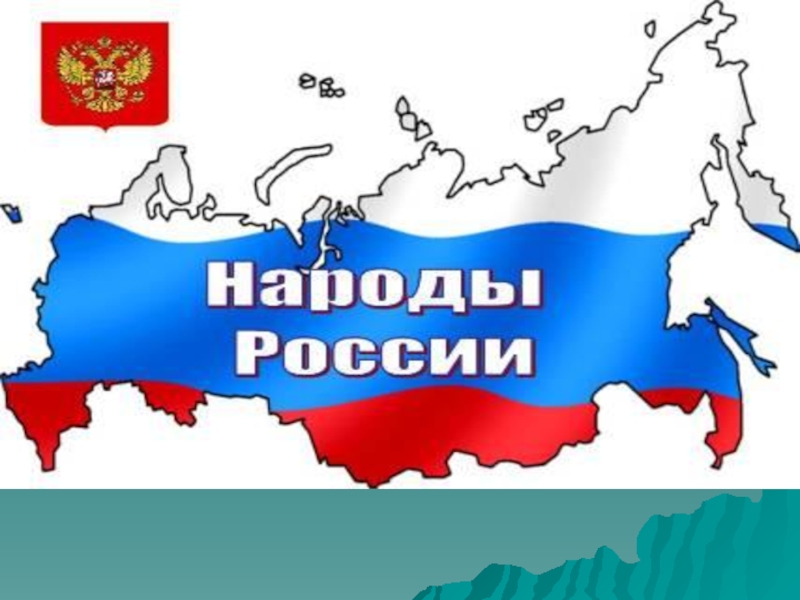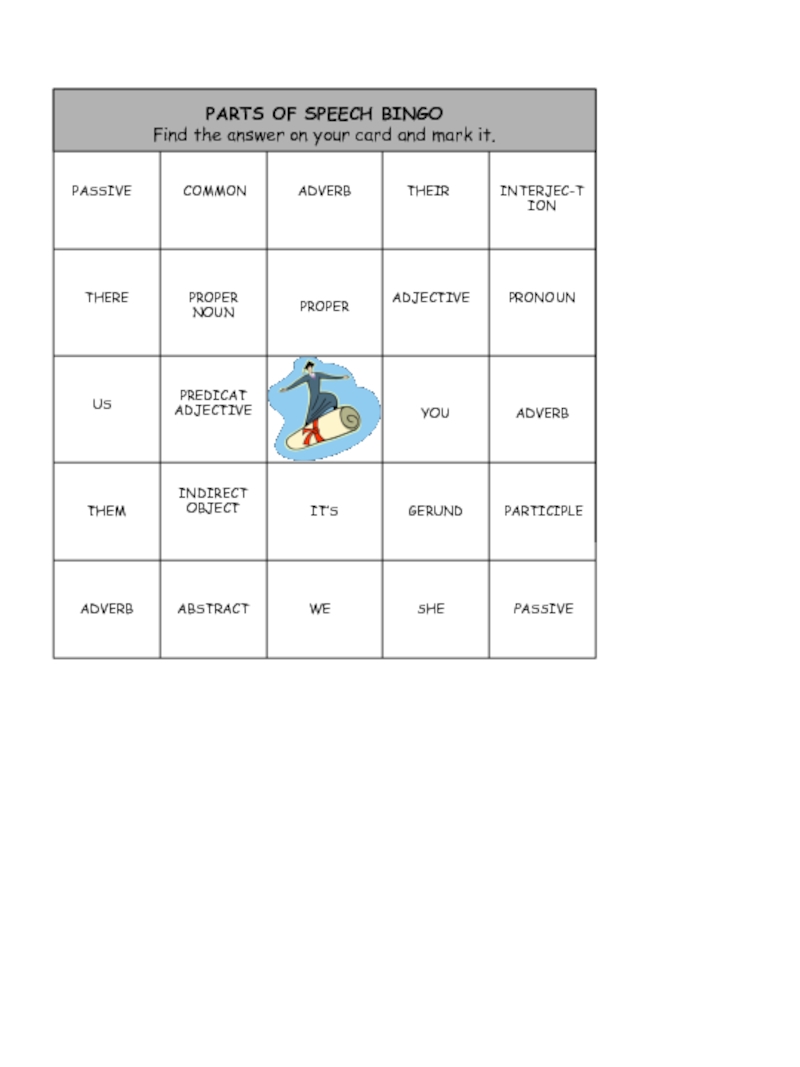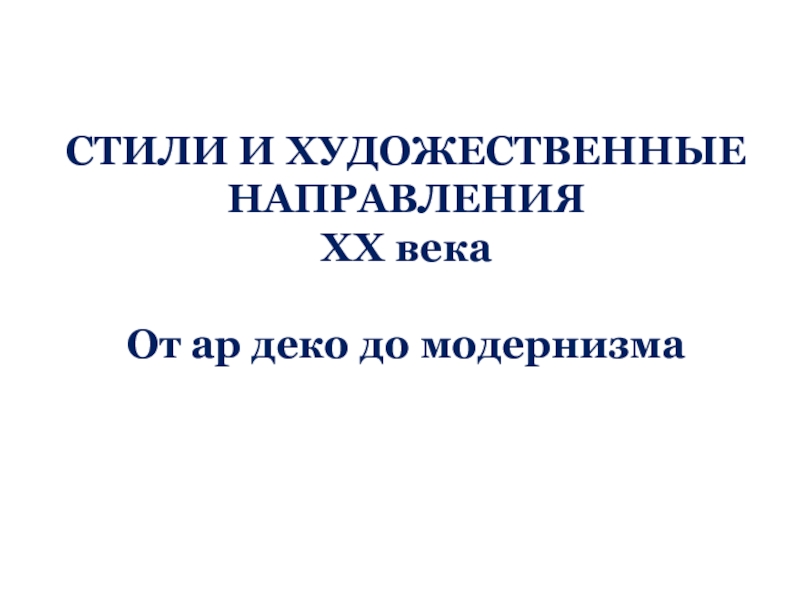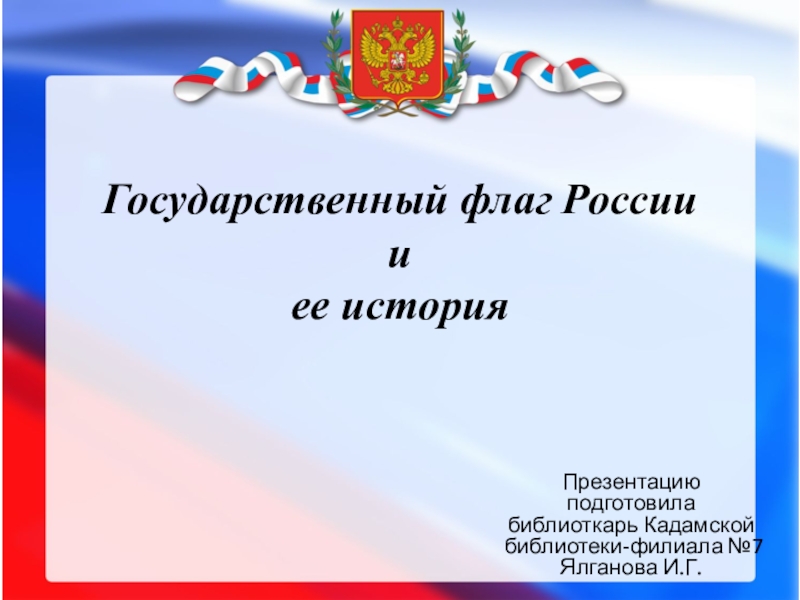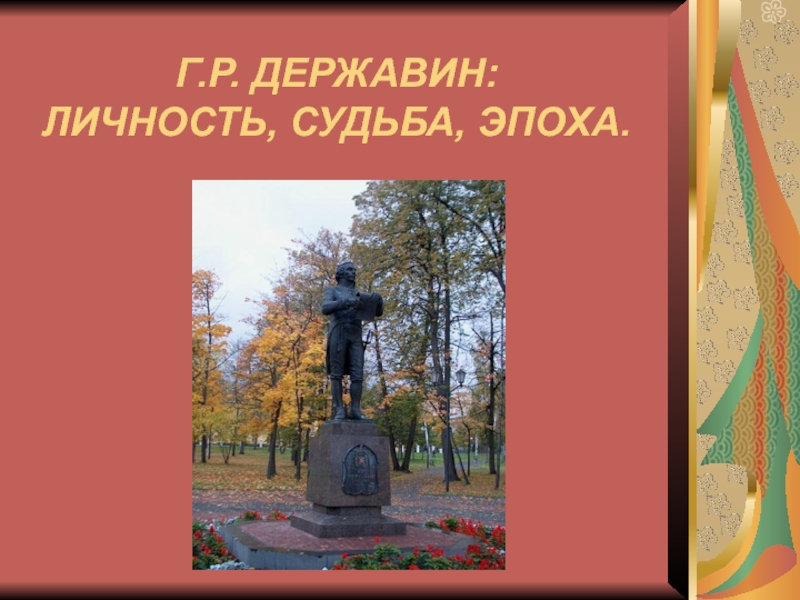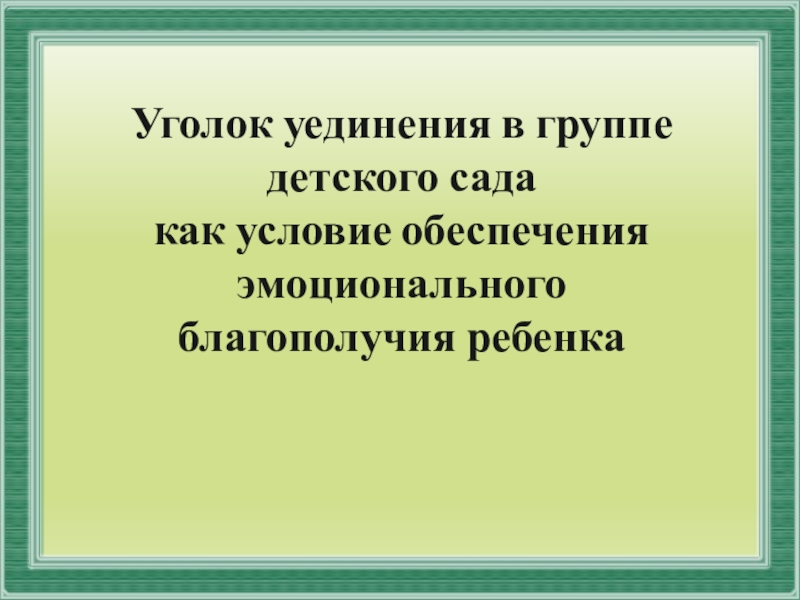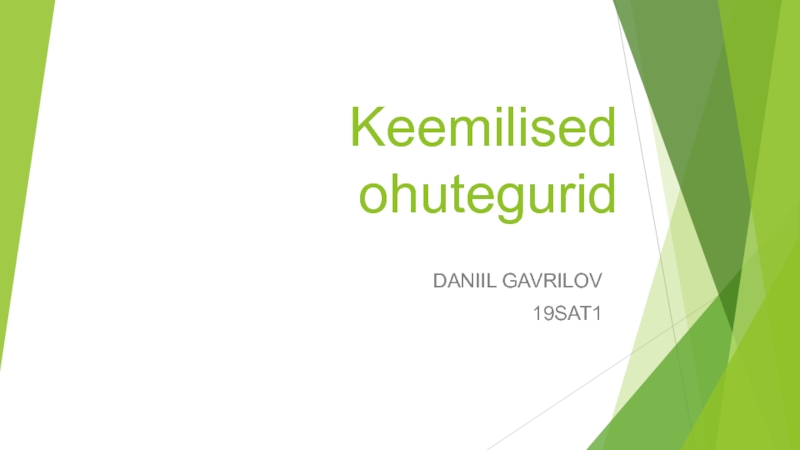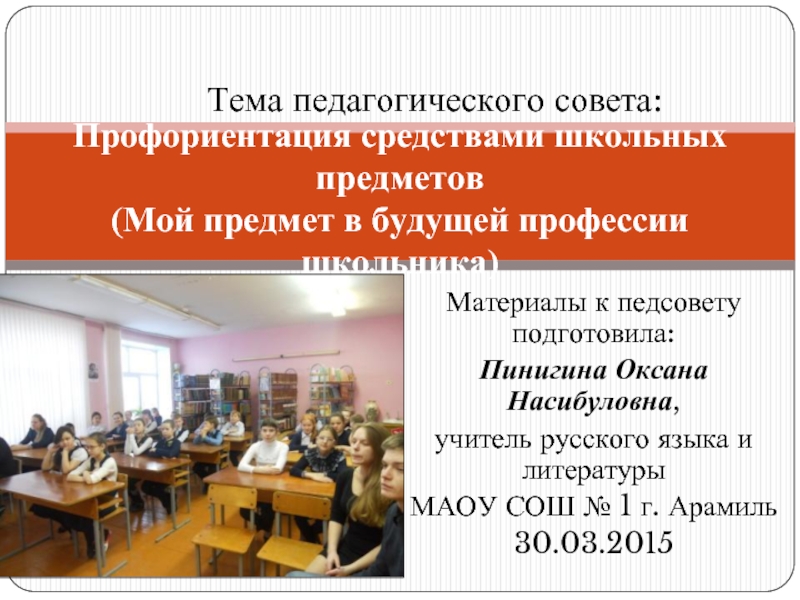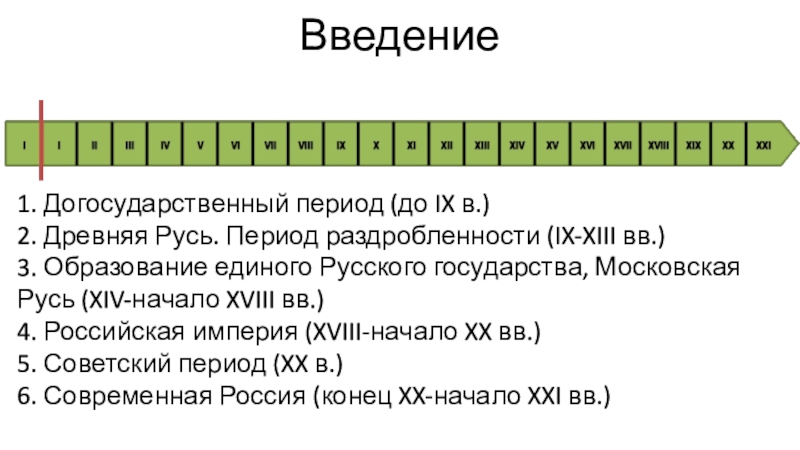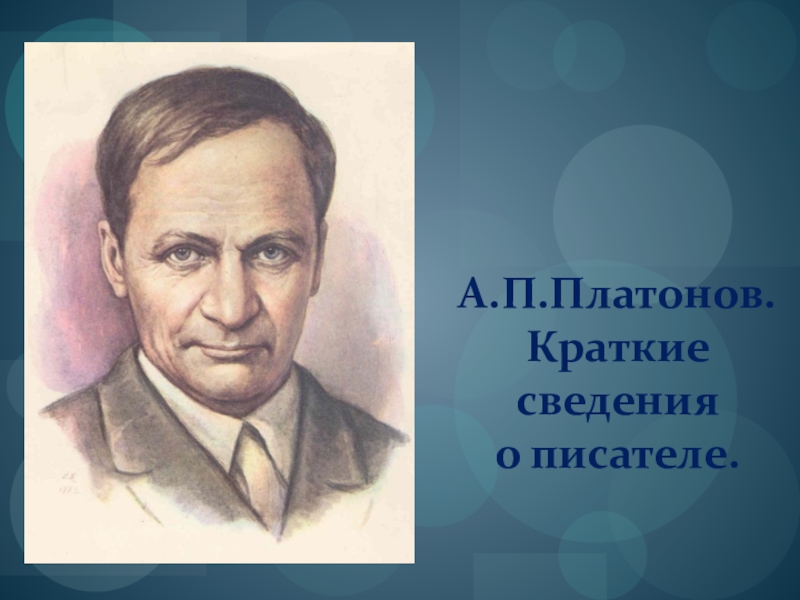Слайд 1HISTORY OF IR:
Medieval Europe & Renaissance Geographic Discoveries Reformation
Halim Nezihoglu
Слайд 2Medieval Era in Europe
The period from about 500 to 1500
is called the Middle Ages or the medieval era in
Europe. Early Middle Ages (500-1000) was a period of decline while in the second period (1000-1500), Europeans experienced a population increase and a new period of dynamism.
In 476, the emperor, Romulus Augustus was deposed by the head of the Germanic conqueror army (end of Western Roman Empire). By 500, the Western Roman Empire was replaced by a number of Germanic kingdoms (Visigoths, Ostrogoths, Vandals, Frankish Kingdom, etc.). Over time, Germans and Romans intermarried; and Germanic and Roman cultures were intermixed.
Слайд 3As the Roman emperor was removed, the Church played an
increasingly important role over the medieval European society and culture.
A strong Pope, Gregory I (Pope from 590 to 604) strengthened the power of the papacy and the Roman Catholic Church. He was especially active in converting non-Christian Germans to Christianity by the help of monks and missionaries. Monasteries played an important role in medieval society.
One of the Frankish Kings, Charles the Great – or Charlemagne (768-814) expanded the territory of the Kingdom and established Carolingian Empire which covered much of western and central Europe.
Слайд 5In 800, Charlemagne entered Rome. He brought the Pope and
the Roman nobles together; and then was crowned by the
Pope as the emperor of the reborn western Roman empire. However, Carolingian Empire fell apart after his death.
In the 9th and 10th centuries, western Europe was under attacks from different directions (Vikings from north and west, Magyars or Hungarians from east, and Muslims from South). Vikings sacked villages and towns; and destroyed Churches. People began to turn to local aristocrats or nobles who could protect them in return for service. This led to a new socio-political system called feudalism.
Слайд 6FEUDALISM
Warriors (vassals) swore an oath of loyalty to their lords
(land-owning aristocracy) and fought for them. The lords, in return,
took care of their needs and gave them lands. Frankish Kings enlarged this system. In return for the land (fief), the lords swore an oath of loyalty to the king. In this way, a pyramid of feudal relationships developed. With the weakening of central government, feudalism spread throughout Europe. At the top was the king, under the king were various ranks of lords, under the noblemen were warrior knights, and at the bottom were serfs (peasants). Each lord was a vassal (i.e. baron), that is, a noble who served a lord of the next higher rank (i.e. duke).
Слайд 7Especially between 1000 and 1300, castles as residences for the
aristocracy and defensible fortifications spread throughout Europe. Aristocracy or nobility
(Kings, great lords, and ordinary knights) had large acres of land (estates) and held political, economic, and social power.
After 9th century, German and Italian lands, which consisted of several city-states and princedoms under the loose rule of the emperor and the Pope, formed Holy Roman Empire. In 955, the Germans, led by King Otto I, stopped the Hungarian advance. Then, The Pope crowned him as emperor of the Holy Roman Empire. Holy Roman emperors viewed themselves as heirs of Charlemagne.
Слайд 10During the Middle Ages, the Catholic clergy gained privileges, acres
of land, and riches. Business of clergymen became highly profitable.
In some areas, local lords came to control many church offices and lands. They appointed close relatives as bishops. They became seekers of wealth and power.
In early the 13th century, the papacy reached the height of its power. The Pope became the final authority in Europe; claimed the right to judge and correct the actions of secular rulers. The Church developed a court known as the Inquisition. Heretics (having any idea or action against the teaching of the Church) were punished (i.e. burnt).
Слайд 11Pope Gregory VII (1075) said: Roman (Catholic) Church was founded
by God alone.. (As he represents God) the Pope’s name
alone shall be spoken in the churches. His name is the only name in the world. It may be permitted to him to depose emperors.. He himself may be judged by no one…
Pope Innocent III (1198) said: … just as the moon gets her light from the sun, and is inferior to the sun.. So the royal power gets splendor of its dignity from the papal authority.
Слайд 12Crusades
From the 11th to the 13th centuries, Europeans carried out
a number of military expeditions, initiated and sponsored by the
Church, to regain the Holy Land (Jerusalem and Palestine) from the Muslims.
First Crusade (1096-1099); Second (1147-1149); Third (1189-1192) ;Fourth (1202-1204); Fifth (1217-1221); Sixth (1228-1229); Seventh (1248-1254); Eighth (1270); Ninth (1271-1272) with several other small-sized expeditions.
Byzantine emperor asked Europeans for help against Seljuk Turks. The Pope viewed this as an opportunity to expand papal leadership.
Слайд 13Knights, soldiers, and youth were motivated by religious fervor and
search for adventure, riches, and social status. Early crusades were
counterattacked by Seljuk Turks; however, they succeeded in occupying Jerusalem (tens of thousands of inhabitants were massacred) and establishing Latin Kingdoms. In 1187, Jerusalem was conquered by Muslims again under Salahaddin Ayyubi. Holy Roman Emperor, King of England, and King of France organized the Third Crusade against Salahaddin, but they were defeated.
Слайд 16During the 4th Crusade, the crusaders sacked the city of
Constantinople; and deposed the Byzantine emperor. Ultimately, crusades failed to
keep the conquered lands; and gave them up to the Muslims by the end of the 13th century.
Europe gained a dynamism after the crusades. Crusades helped break down feudalism. Kings increased their authority over nobles by raising large armies in place of small feudal forces. As a result of interactions with the Muslims, demand for luxury goods increased; new trade routes opened up; and living standard improved. Breaking up isolation, they paved the way for later geographic discoveries. They learnt to draw more accurate maps and build better ships and weapons.
Слайд 17Improved farming techniques increased agricultural production. Population doubled between 1000
and 1300, from 38 to 74 million.
Coastal cities (esp. Italian)
gained prosperity owing to Mediterranean trade. As a result of revival of trade, towns and cities grew. Money economy replaced barters. Trading companies and banks were set up. Merchants needed freedom to trade and their own rules to make profit. They rebelled against feudal lords and created independent city-states in Italy. Wealthy merchants and artisans of the cities came to be known as burghers and later as bourgeoisie.
Слайд 18Around 1150, a new interest in learning developed in western
Europe. Universities apart from monastery and cathedral schools were established.
Scholars acquired new knowledge from the scientific writings of Muslims and from the works of Aristotle. They developed a renewed interest in the physical world. Much knowledge in areas such as science, medicine, and architecture was transferred from the Islamic to the western world during the crusade era. By 1500, there were 80 universities in Europe.
Слайд 19In the 12th and 13th centuries, kingdoms rose to power
in Europe (Kingdoms of France, England, Portugal, Scotland, Ireland, Denmark,
Norway, Sweden, Sicily, Hungary, Poland, Kiev) besides Byzantine Empire and Holy Roman Empire.
French King Philip II, who ruled from 1180 to 1223, expanded the territories of the French Kingdom and increased his power. Philip IV, ruled from 1285 to 1314, strengthened the French monarchy by expanding the royal bureaucracy; and established the first French Parliament (Estates-General) which was composed of three classes – the clergy (first estate), the nobles (second estate), townspeople and peasants (third estate).
Слайд 20English nobles resented the rise of the King’s power at
the expense of their power, and rebelled during the reign
of King John of England. In 1215, they forced the King to put his seal on a document of rights called Magna Carta, or the Great Charter. It regulated mutual rights and obligations between King and lords. Monarch’s power was not absolute but limited. During the reign of Edward I, English Parliament also emerged. It was composed of two knights from every county, two people from every town, all nobles and bishops in the country. Nobles and church lords formed the House of Lords; knights and townspeople, the House of Commons.
Слайд 21The Late Middle Ages
Black Death: An epidemic disease, spread by
black rats, killed many people especially in crowded and unsanitary
towns and cities. Out of 75 million people, more than 30 million people died of the plague between 1347-1351.
Farming production and trade declined. Declining revenues weakened European monarchies. To raise their income they conquered more productive lands; and forced clergymen to pay taxes. This increased tension between Papacy and the kings. By early 15th century, the Church’s political position declined. Nobility struggled to get back their feudal privileges. Serfdom disappeared.
Слайд 22Hundred Years’ War
A series of wars between England and France
(1337-1453), fought in French territories. By 1429, English forces, as
more united and technically superior, controlled half of French territories (Normandy, Flanders). Later, with a new spirit, mobilized by Joan of Arc, the French drove the English out of their country. This victory gave the French people a new sense of national unity. The English eventually abandoned permanent claims on the European mainland. After the war, noble cavalry were replaced by standing royal armies, which contributed to the rise of centralized national kingdoms and decline of feudal order.
Слайд 23During the 15th century, European monarchs set up strong central
governments (England, France, Spain, Poland, Hungary..) by limiting the power
of clergymen and nobility. Holy Roman Empire began to be ruled by Habsburg dynasty, which became the most powerful royal family in early 16th century. Their domains included Spain, Austria, Italy, and German princedoms.
By the late 1400s, new techniques and inventions increased production. Trade expanded; and cities increased their wealth. Significant changes took place in the making and use of metal. About 1440, Gutenberg invented printing press; and so books could be printed quickly by machine. New ideas spread more rapidly. With the growth of educated urban groups, Europe was ready for Renaissance.
Слайд 25RENAISSANCE
Within several crises such as black death, economic decline, poor
harvests, weakening authority of monarchies, corruption among the Church leaders,
rebellions, conflicts, and wars (Hundred Years’), western Europe experienced a profound intellectual and cultural awakening known as the Renaissance (Rebirth) (from about 1400 to 1600).
Слайд 27Muslim Contributions to Renassiance
During Europe’s darkness, Muslims experienced a golden
age in which centers of research and libraries were located
in brilliant Muslim cities.
Muslims not only preserved the knowledge of the ancient Greeks passed it on to the Europeans, but also significantly contributed to it and by adding to and correcting many branches of this knowledge such as mathematics, astronomy, medicine, politics, and law, to mention a few. The works of Al-Kharizmi, Al-Tusi, Ibn Sina, Ibn Rushd, Ibn Khaldun, Al-Farabi, Al-Razi, Al-Biruni, etc. were studied by European scholars.
Слайд 28For example, Copernicus borrowed from the works of Ibn al-Shatir
and other Muslim astronomers in order to construct his own
lunar model.
The word "algebra" comes from "Al-Jabr", which is taken from the title of the book Hisab Al-Jabr wal Muqabala by Muhammad ibn Musa al-Kharizmi (780–850).
George Rafael says: “From algebra and coffee to guitars, optics and universities... the West owes to the People of the Crescent Moon... A millennium ago, while the West was shrouded in darkness, Islam enjoyed a golden age. Lighting in the streets of Cordoba when London was a barbarous pit; religious tolerance in Toledo while pogroms raged from York to Vienna. As custodians of our classical legacy, Arabs were midwives to our Renaissance.”
Слайд 30Italian scholars developed an enthusiastic interest in classical writings (humanism).
They learnt Greek and Latin and studied old manuscripts. As
they studied, humanists came to admire classical culture and adopted many Greek and Roman ideas. The most important idea they accepted was the dignity and worth of the individual. Humanism also meant an enthusiastic concern for people, all aspects of human life and the world, and freedom for individual initiative.
In independent city-states (Florence, Venice, Rome), they carried out new endeavors in a variety of fields.
Слайд 32Mediterranean trade and textile production brought prosperity and wealth. Wealthy
merchants and bankers replaced landed nobility.
Resident embassies emerged.
Writers and thinkers
improved new styles of literature, new methods of education, new methods of research in search for truth, critical approach to long-lasting dogmas, and new rules of conduct (Machiavelli). This led to growing dissatisfaction with the restraints imposed by traditional political and religious athorities.
Interest in knowledge, art, science, sports, wealth, and politics increased in the society. Architecture, home-design, city-design, sculpture, painting, all developed. (Leonardo da Vinci, Michelangelo, Raphael..)
Слайд 33REFORMATION
Around 1500, educated western Europeans were calling for a reformation
in the ways the Church taught and practiced Christianity because
of abuses and corruption of the popes and clergymen. Kings and princes were also dissatisfied with papal and imperial authority and interventions over themselves.
In the late 1300s, John Wycliffe spoke out against the papacy. He claimed that the Bible was the sole authority for religious truth; criticized the Church’s wealth and its hierarchy of clergy; and called for an end to church ceremonies that were not mentioned in the Bible.
Слайд 34In the early 1500s, a movement for Church reform arose
in Germany. It eventually led to a permanent split in
Christianity and created Protestantism. Protestant Reformation was begun by Martin Luther.
Luther’s teaching was that religious truth and authority lie only in the Bible, not in the institutions of the Catholic Church. Salvation is possible by faith alone without the help of clergymen. Clergymen have no intermediary role between God and believers.
Printed copies of Luther’s writings spread throughout Europe. Northern Germany became mostly Lutheran. Princes supported his ideas in order to increase their own power against papal and imperial authority.
Слайд 35Holy Roman emperor (from Habsburg dynasty) brought his army to
German lands to crush Lutheranism. Unable to defeat German princes,
who were also supported by the king of France, signed the Peace of Augsburg (1555) which formally accepted the division of Christianity in Germany. German princedoms were now free to choose between Catholicism and Lutheranism.
Calvinism / Anglican Church / Anabaptists .. / split from Rome / France, Spain, Italy, Hungary, Poland remained as Catholic / continuing tension and later migrations to North America by seeking religious freedom
Слайд 36Catholic Church also revitalized itself by strengthening their doctrine. The
Jesuit missionaries spread Catholicism to eastern Europe and other parts
of the world through schools and education.
Against the challenges from the rise of secularism and Protestantism, Catholic Church restored its power in southern Europe in the 16th century and put an end to the Italian Renaissance. The Church censored the press and suppressed freedom of intellectual life.
Слайд 38Copernicus was afraid to publish his ideas; and his book
did not appear until after his death in 1543. He
claimed that the sun was the center of the solar system and that the earth revolved around the sun. Then, in 1609, the Italian mathematician Galileo built a telescope. He found that Copernican theory was correct.
The idea that the earth was not at the center of the universe was contrary to the teachings of the Catholic Church. Church leaders were so alarmed by this idea that Galileo was brought before the Inquisition and forced to deny his claim to escape from death.
Слайд 39Certain parts of the doctrine of the Catholic Church have
in the Christian world created an idea of contradiction between
science (knowledge) and faith.
Newly emerging scientists began to adopt a conception which claims that man attains knowledge only if he disobeys the teachings of religion. It is this conception which has divided the European history of culture into two distinct periods, namely the age of faith and the age of science, and has placed science and faith in opposition to each other. Science rose to the detriment of faith in European history in contrast to the history of Muslims in which both rose or fell together.
Слайд 40Geographic Discoveries and Expansion
Renaissance also led to geographic discoveries and
early colonization (Portugese and Spanish expansion) by the 16th century.
By a new spirit, dynamism and perspective, Europeans became more self-confident and began to look beyond their own locality and continent. They got involved in overseas voyages to settle new lands; to spread Christianity; and to search for wealth. Many Europeans became rich as a result of wealth acquired from Asia, Africa, and the Americas.
Improvements in ship-building and navigational tools, handguns and cannons helped Europeans for geographic expansion.
Слайд 41Economic needs because of wars between monarchs, and search for
gold and silver for having strong armies forced the kings
to organize overseas voyages for highly profitable trade and exploitation.
Silk and spice way was controlled by the Muslims, and so Europeans were looking for alternative routes to India an south Asia.
Слайд 43A new approach in national economic policy called mercantilism also
developed. According to it, wealth meant power. The richer a
nation was, the more powerful it was. Wealth was measured by the amount of gold and silver, a nation owned.
Kingdoms competed with one another to gain as much wealth as possible. This could be done by extracting gold and silver from mines or through trade. They sought to create a favorable balance of trade by exporting more goods than they imported (self-sufficiency). Colonies were the sources of raw materials and markets for finished products. Newly discovered lands and colonies meant agricultural products, mines and precious metals, job and investment opportunities, religious freedom, etc.
Слайд 44The Portuguese became the first Europeans to build an overseas
empire. They established trading settlements in African, Asian, and Brazilian
shores. When they were defeated by the Spanish in 1580, Spain replaced them.
Christopher Colombus, as an Italian navigator, was sponsored by Spanish King and Queen in his voyage leading to the discovery of America.
In the late 1500’s and early 1600’s, gold and silver accounted for 80 percent of the value of the cargoes shipped to Spain.
Слайд 45“Just twenty-one years after Columbus's first landing in the Caribbean,
the vastly populous island that the explorer renamed Hispaniola was
effectively desolate; nearly 8.000.000 people… had been killed by violence, disease, and despair. What happened on Hispaniola was the equivalent of more than fifty Hiroshimas. And Hispaniola was only the beginning.”
(David E. Stannard, American Holocaust: Columbus and the Conquest of the New World, 1992)
In Mexico, native population dropped from 25 million in 1519 to 1 million in 1630.
Слайд 46“As the slaves come down to Fida (a port on
the west coast of Africa), they are put into a
prison, built for that purpose, near the beach, all of them together; and when the Europeans are to receive them, they are brought out into a large plain, where the surgeons examine every part of them, men and women being all stark naked. Those who are found good and sound are set on one side… Each of them is marked with a red-hot iron, imprinting the mark of the French, English, or Dutch companies, so that each nation may distinguish it own…”
(Elizabeth Dorman (ed.), Documents Illustrative of the Slave Trade to America, 1930.)
The number of African slaves traded: 275.000 (16th cen.), over a million (17th), about six million (18th)
Слайд 47By 1600, Spain had reached its peak as a European
and colonial power. However, its easily acquired wealth eventually led
to its decline. Spain spent too much money on wars with its rivals. As the supply of gold and silver rose, the demand for goods increased. So, prices and wages climbed. Inflation reached 400 percent. By the fall of production and increase in importation of the goods from other European countries, this wealth is transferred to the producers. As a result, Spain’s dominance of the New World got weakened. Its colonies were opened to the other European powers.
Слайд 49The other European powers (England, France, Holland) watched the growing
Portuguese and Spanish triumphs first with envy and then with
alarm. English attention focused on North America. English settlers pushed the Indians out; and established a permanent settlement. First colonial competitions between major European powers emerged in the 16th and 17th centuries. By the mid-17th century, the Dutch fleet was the largest; and Dutch merchants traded in every continent on the globe.
Слайд 50By 1700’s, Dutch power began to decline because of exhausting
wars and they were replaced by the rising power of
France. England soon became alarmed by France’s rapid expansion overseas and its dynastic ambitions in Europe. The overseas rivalry turned violent – from 1689 to 1763, France and England waged a series of wars on the continent and abroad. The French were ultimately defeated by the English and surrendered North America, Canada, and India to Britain. By the end of the 18th century, Britain had the greatest gains in European colonial rivalry; and it was the strongest naval power in Europe.
Слайд 51Britain also pursued a balance of power vs. its European
rivals; and acted as the third balancing nation. It sought
to prevent the rise of a hegemonic force or the rise of an anti-English coalition. It cooperated with its less rival against the main rival; or sided with the weaker power against the stronger one.
Слайд 52Religious split (between Catholics and Protestants) also had led to
a series of religious wars in the second half of
the 16th and first half of the 17th centuries, such as French wars of religion and Thirty Years’ War (1618-1648).
Thirty Years’ War involved wars between Protestants and Catholics, Holy Roman Empire, princedoms and kingdoms. Germany lost about one-third of its population.
Слайд 54Treaty of Westphalia (1648) ended Thirty Years’ War. Holy Roman
Empire remained divided into over 300 separate independent German princedoms
and states (the largest ones Prussia and Austria). HRE became neither holy, nor roman, nor an empire. France became Europe’s leading power. National kingdoms rose to power against imperial and papal authorities. The balance of power principle influenced relations among major European powers for the next three centuries.
General recognition of the sovereignty of each party over its lands, people, religious affairs..
Sovereignty, non-intervention, international relations on equal basis, religious toleration
Слайд 55After the Seventy Years’ War (1756-1763), between Austria and Prussia
and between France and England, England replaced France as the
leading colonial power.
The American War of Independence (1775–1783) began as a war between the Kingdom of Great Britain and thirteen British colonies in North America, and concluded in a great war between several European great powers. France, Spain, and the Dutch Republic supported the revolutionaries and fought against Britain. The Treaty of Paris (1783) ended the war and recognized the independence and sovereignty of the United States.
Слайд 56From 1500’s to the 1700’s, absolute monarchies reached the height
of their power in Europe. They held supreme power and
worked to overcome potential rivals among their nobles. They created strong nations in which the loyalties of all their subjects were directed to the Crown. Central bureaucracy was strengthened to bring many areas of national life under royal control. Tsarist Russia was also an absolutist-bureaucratic state as the tsar was not only all-powerful, but the head of an overwhelming apparatus of bureaucracy as well.
Kings ruled by divine right of rule. Do Boga vysoko, a do tsaria daleko / I am the state (Louis XIV)
In Britain, Cromwell / execution of King / restoration of a limited, constitutional monarchy / Bill of Rights
Слайд 57Rise of Russia
Reforms of Peter the Great strengthened Russia’s role
in foreign affairs. Russian military triumphs against Sweden forced the
European powers to recognize Russia as a major power. Catherine II greatly expanded Russia’s borders to the south. She acquiered territory from Poland. She achieved the goal of Peter the Great for a warm-water port on the Black sea (Sea of Azov and the Crimean Peninsula). Reforms aimed at westernization and modernization of Russia and strengthening of the Russian army.
Слайд 58Central Asia
After the Timur’s attacks, due to the struggles for
the throne and the continuation of fights among Turkic clans,
the Golden Horde began to weaken gradually. Golden Horde domain divided into various khanates such as Astrakhan, Khazan, Crimea, Orda, Nogai and Sibir at the beginning of the fifteenth century. This created an opportunity for the Russians to start the annexation of Central Asia. They invaded Khazan in 1552, Astrakhan in 1556 and then Volga and northern regions of the Caspian Sea, thus cleared the access of Central Asia.
Слайд 59Petro the Great established war academy and schools for artillery
and engineering. He directed that the researchers should prepare maps
showing routes to the Caucasus, Central Asia, China and India. Several expeditions, made toward Central Asian regions in the 18th and especially in the 19th century, helped the Russians see the decrepitude of their adversaries, their inferior and antiquated weapons, their disunity and constant quarrelling, and consequently, learn how to overpower Central Asians. Accordingly, they brought the steppe peoples under their control without much hardship.
Слайд 60Although the peoples of Central Asia were in a disadvantageous
position compared with the Russian superior power, they made every
effort to struggle against this invasion and valiantly fought the Russians. The nomadic Kazakhs, the Kyrgyz and Turkmens played a vital role in forming an outer ring of defense to protect the last CA khanates of Bukhara, Khiva and Khokand. The light nomadic forces skillfully carried out a series of guerrilla attacks. They captured the tsarist officers and their trains. They also burned Russian supply ships, as means of exploitation on the Caspian Sea, that were carrying cattle, sheep, horses, camels, silk, cotton, fur, carpet and other wealth of Central Asia.
Слайд 61Because of this strong resistance by Central Asians against organized
Russian army equipped with up-to-date heavy weapons, the Russian expansion
that began at the beginning of the 16th century managed to reach Tashkent in 1865. In order to overthrow this resistance, Russia was obliged to build a series of fortified posts, which strengthened Russia’s defenses against the inroads made by the Kazakh and Kyrgyz horsemen, and facilitated preparations for a further forward advance. Meanwhile, the Russians constructed about forty-six forts and ninety-six redoubts.

